#Hire Train and Deploy Program
Explore tagged Tumblr posts
Text
Hire Train Deploy | Hire Train and Deploy | Maintec
Revolutionize Your Workforce with Maintec's Hire-Train-Deploy Solution
Experience a seamless integration of talent into your team with Maintec's Hire-Train-Deploy program. We identify top-tier candidates, provide comprehensive training tailored to your needs, and swiftly deploy skilled professionals to tackle your projects head-on. Let Maintec elevate your workforce, ensuring efficiency, productivity, and success in every endeavor.
#hire train deploy#Hire Train and deploy#Hire train and deploy program#Hire train and deploy companies in India
0 notes
Text
Hire Train Deploy Program for Tech Talent | upGrad
upGrad’s Hire Train Deploy Program enables companies to source, upskill, and onboard software talent tailored to project needs. Reduce hiring costs and ramp-up time with job-ready engineers trained in full-stack development, data, and cloud technologies.
#Hire Train Deploy Program#software hiring solutions#tech staffing#workforce readiness#IT upskilling
0 notes
Text

Explore Mazenet's customized Hire Train Deploy model to access job-ready, day-1 billable resources for your enterprise.
#train and hire program#train and hire#zero cost hiring#recruit train deploy#recruit train deploy model#Hire Train Deploy Model#train and hire companies#companies that train and hire#hire train deploy#Hire Train Deploy Program#hire train deploy companies.
0 notes
Text
In his first two weeks of office, President Trump signed several Executive Orders (EOs) to fulfill one of his many campaign promises—to reduce the size of the federal government. He has rolled back diversity, equity, and inclusion (DEI) initiatives, asserting that the federal government will no longer consider race, ethnicity, or other federally protected characteristics in hiring and retention decisions. In recent days, he announced a financial buyout to federal employees who do not wish to comply with the new Return to Office (RTO) mandate, which requires employees to be in an office for five days per week, despite concerns about available office space. The details of the buyout were outlined in an email with the subject line, “Fork in the Road,” sent by the Office of Personnel Management (OPM) on January 28, 2025, to over 2 million federal workers. The OPM also offered deferred resignation where federal employees could resign immediately and still be paid for the next several months. Meanwhile, those who decide to stay are not promised future employment and the memo stated new conditions for employees, that they be “loyal, trustworthy, and to strive for excellence in their daily work”; principles that likely will become benchmarks for future performance reviews.
Under the Trump administration, federal workforce reductions will happen, along with a greater deployment of artificial intelligence (AI), automation, and outsourcing to private firms. These new services will cost millions of dollars to design, deploy, and train the federal workforce, creating new national and data security threats as well, given the level of protected information at stake. But the influence of Big Tech leaders, who are formally and informally advising President Trump and his administration, may be accelerating a smaller government workforce based on their own values about corporate governance. Big Tech companies were among those that led the RTO mandates for their own employees after the pandemic with similar terms and conditions, as well as promises made that were not kept. Many of these same companies are making AI more technically advanced without realizing that millions of people are still impacted in the U.S. by the lack of digital access. As Biden era policies were working to address the connectivity challenges faced throughout the U.S., these programs are now being challenged, which will almost guarantee that even the best of AI technologies embedded in government functions may be inaccessible to most people.
78 notes
·
View notes
Text
Claire Wang at The Guardian:
Those who failed to produce papers were arrested. More than 400 people were detained and forced on a train back to Mexico, a place many had never been.
It’s a scene many fear will come to pass in president-elect Donald Trump’s second term, especially after he doubled down on a campaign promise to “launch the largest deportation operation” in US history, and confirmed he would use the military to execute hardline immigration policies. But this particular episode happened in 1931, as part of an earlier era of mass deportations that scholars say is reminiscent of what is unfolding today. The La Placita sweep became the first public immigration raid in Los Angeles, and one of the largest in a wave of “repatriation drives” that rolled across the country during the Great Depression. Mexican farm workers, indiscriminately deemed “illegal aliens”, became scapegoats for job shortages and shrinking public benefits. President Herbert Hoover’s provocative slogan, “American jobs for real Americans”, kicked off a spate of local legislation banning employment of anyone of Mexican descent. Police descended on workplaces, parks, hospitals and social clubs, arresting and dumping people across the border in trains and buses.
Nearly 2 million Mexican Americans, more than half US citizens, were deported without due process. Families were torn apart, and many children never again saw their deported parents. Hoover’s Mexican repatriation program is, among mass deportation efforts in the past, most similar to Trump’s stated plans, said Kevin R Johnson, a professor of public interest law and Chicana/o studies at the University of California, Davis, School of Law. [...] Since his first presidential run, Trump has invoked President Dwight D Eisenhower’s mass deportation program as a blueprint for his own agenda. During the second world war, the US and Mexican government enacted the Bracero program that allowed Mexican farm hands to temporarily work in the US. But many growers continued to hire undocumented immigrants because it was cheaper. In 1954, the Eisenhower administration cracked down on undocumented labor by launching “Operation Wetback”, a yearlong series of raids named after a racial epithet for people who illegally crossed the Rio Grande. [...] The politics of deportation have always contained an important “racial dimension”, said Mae Ngai, a historian whose book Impossible Subjects explores how illegal migration became the central issue in US immigration policy.
Trump has deployed racist tropes against various ethnic groups, including Mexicans as drug-dealing “rapists” and Haitians as pet eaters, while lamenting a lack of transplants from “nice”, white-majority countries like Denmark and Switzerland. Last month, sources close to the president told NBC News that he could prioritize deporting undocumented Chinese nationals. “He’s been very clear about going after people of color, people from ‘shithole countries,’” she said, referring to a 2018 remark from Trump about crisis-stricken nations like El Salvador and Haiti. Trump could plausibly deport a million people using military-style raids of the Eisenhower-era, Ngai said, but it is unlikely that he can expel 11 million undocumented immigrants. (According to an estimate by the American Immigration Council, deporting 1 million people a year would cost more than $960bn over a decade.) Still, Ngai said, his rhetoric alone could foment fear and panic in immigrant communities. But Eisenhower’s immigration approach also differed from Trump’s in notable ways, Ngai said. Though the administration did launch flashy raids, it also allowed farm owners to rehire some deportees through the Bracero program, essentially creating a pathway for authorized entry into the US. So far, Ngai said, Trump has hammered down on deportations without providing an option for legal immigration or naturalization. “He doesn’t know the whole story of ‘Operation Wetback’,” she said. Deportations also appear to have harmed the local economy.
Donald Trump’s mass deportation proposal hasn’t been the first time the US conducted mass deportations of Mexican-Americans, as it happened during the Herbert Hoover and Dwight D. Eisenhower’s presidencies. The deportations were ruinous to economies and were a human rights disaster, and Trump’s plan repeats that but turbocharges it.
#American History#Mass Deportations#Donald Trump#Herbert Hoover#Mexican Americans#Ethnic Cleansing#Dwight D. Eisenhower#La Placita Park#Operation Wetback#Bracero
56 notes
·
View notes
Text
In the earlier phases of the war, neural pilots were few and far between. They were rarely deployed at all, for fear of their death, of having to program a new pilot to take their place.
When they were deployed, they tore through everything in their path, mercilessly rending all who opposed them apart, desperate for the approval of the reward drives that would flood in with every beautifully well-aimed shot, every delicious punch, every perfect kill. They were death incarnate- unstoppable machines of war with only one purpose- kill the enemy.
And kill they did. When a neural pilot was deployed, a freshly hired anti-mech infantry unit would train its sights on it, trying to line up a shot that’d surely get them into the history books. A veteran would simply run- even thinking about lining up a shot against something that fast was a fool’s endeavour, one guaranteed to result in the death of them and anyone within a hundred meters of them.
An analogue pilot wouldn’t run. Pilots of the time were too proud to run. They’d been told they were the best of the best, the strongest there was, Stormcell’s finest, the bane of their enemies, and they would chant patriotic mantras as they flew forward to their inevitable deaths. Their patriotic, childish rhymes would turn to wide-eyed shock at the sheer speed their target was exhibiting, and their shock would turn to fear as they tried and failed to outrun the power of pure, unfiltered bloodlust.
On the rare occasions that two neural pilots met on the battlefield, what resulted was incredible. Plasma blades would clash at speeds beyond what most pilots could ever hope to achieve, gunshot would burst the eardrums of anyone unlucky enough to be close by, missile arrays that most pilots didn’t even know they had would be fired, reloaded, fired again before an untrained onlooker could even think. And of course, nobody close by would have a hope of surviving- if they weren’t intentionally taken out by one of the pilots, they’d take a stray bullet, be just too close to a missile deflected by the defense arrays, or simply reduced to ash by a thruster.
For the pilots, one would expect this experience to be the most stressful experience of their existence, but that was far from the case. The reward drives turned up their releases of dopamine whenever fighting against capable opponents, and no opponent was more capable of defeating a neural than someone built on the same programming as them. To them, this murderous war was more akin to an intimate dance. Every clash of blades was a perfectly timed intertwining step, every blocked missile a pirouette, every shot fired a step.
And when they finally recognised they were dealing with one of their own kind, rather than just a really skilled analogue, it evolved into something more. Every frenzied punch was a fleeting touch, every desperate kick a gentle hug, every shot to the reactor core a passionate kiss. When they knew what they were fighting, formality was discarded, and the pilots scrambled to reap as much dopamine as the reward drives could give them, performing the most intricately calculated attacks with little more than a thought as to the consequences on their bodies. They certainly knew deep down that their fights would end up breaking one or both of them, but they didn’t care. They just wanted the fight to last.
Clashes between neural pilots tended to last an incredibly long time. Some were recorded to go on for days on end, whilst neural-analogue fights took seconds to be decided. Energy expenditure levels from the reactors tended to peak around the start of the fight from each neural mech, reactors often approaching overload, before slowing down as the combatants approached breaking point- not for their own safety, but for their opponent’s. Whilst the pilots knew that they were fighting evil people who wanted nothing more than to see everything they knew crumble, every cell in what little remained functioning of their brain called to prolong the fight as long as possible, to keep it going, to just stay here, clashing with their perfect enemy, their perfect match, for as long as they could.
While others watched on in fear, scrambling to escape the savage brawl, the pilots wanted the moment to last forever.
Where the less educated saw hatred, the pilots experienced something they shouldn’t have been able to feel- love.
#creative writing#writeblr#mecha#mechaposting#mechposting#writers on tumblr#glory to stormcell#OH MY GODS I FINALLY HAD MORE IDEAS YAY#WHY DID IT TAKE ME A FULL ASS MONTH TO COME UP WITH SMTHN#anyway sry this isnt as long as most of my writings! just wanted it done lol
14 notes
·
View notes
Text

#TomcatTails Number 21
#TomcatTuesday
“You can earn a year’s worth of flight pay in one night at the boat.”
I think most Naval Aviators have said at one point (or maybe more) words to this effect: “This job is so cool, I can’t believe they’re paying me!” A 1v1 on a clear, blue-sky day that goes your way. A rock-and-roll low level to bomb where your weapon fuses within 3 seconds of the required time on target (TOT). A day-di*k-around off the boat to an OK 3-wire on return. Those were great and heady times in the mighty Big Fighter and much fun was had by all.
They even paid us extra for the pleasure. We called it “flight pay” but the actual term was ACIP or Aviation Career Incentive Pay. Naturally, the Navy spent a LOT of money teaching us to fly and to preserve that investment the Navy offered ACIP as well as the occasional bonus to stay in past certain career milestones. The bonuses varied according to the airlines hiring rates; if they were hiring hard, the bonuses came in. This is no different than other services and even extended to some of the more crucial Enlisted rates with reenlistment bonuses in the 10s of thousands of dollars. It makes good business sense to try and keep your people in since they cost so much to train.
We can debate the efficacy of these programs all day. Some argue that they don’t really retain people, some will say they’ll influence the “fence sitters” to take a bonus and stay. And if you were a “fence sitter” that wasn’t sure and the Navy offered you a $40-$50K bonus to stay in and you took it, you weren’t “sitting on the fence”, you were “chained to the fence” for 6 more years. Funny, huh?
But all those things only mean something in day/VFR flying. If you deploy aboard the ship, turn out the lights (night), blot out the moon & stars with clouds, make that flight deck pitch up and down and then lose your critical attitude/angle-of-bank displays, that calculus changes significantly. Now there’s not enough gold in Fort Knox to make flying worth it. Not by a long shot.
The old saying goes that you make your flight pay during one flight per year. It might be a bad night at the boat. It might be a scary weak catapult shot. It might be a near mid-air. But they all have the same thing in common; that feeling in your gut that “this is bad.” You know that feeling you get in your lower body, your groin or loins or like deep in your belly when a cop lights you up when he’s behind you? That sinking/queasy/weird visceral reaction to those blue and red lights? In carrier aviation, this has long been described as a “shot of cold piss to the heart” or a “cold shot of piss to the heart”. Either way you say it, it’s accurate and the key difference is that it isn’t just momentary like when the cop’s behind you; it lasts a while until you can get your head straight and compartmentalize everything going on around you where it needs to be so you can function, so you can operate your jet despite all the problems.
Compartmentalizing is how aviators cope with all kinds of things going on in our head. Problems at home? There’s a compartment for that. Career worries? There’s a compartment for that. Kid is sick? There’s a compartment for that. There are enough compartments for all the issues you have in your head, and anything not directly involved in aviating, navigating, or communicating needs to be in its compartment. That’s really important on even the most routine flight. Remember that famous quote I posted on several occasions? This one:
“Aviation in itself is not inherently dangerous. But to an even greater degree than the sea, it is terribly unforgiving of any carelessness, incapacity, or neglect.”
If anything you’ve stuffed in compartments comes out in flight, especially during an emergency or challenging conditions, it (and any others) will contribute directly to carelessness, incapacity, or neglect. To put it bluntly (profanity warning): Shit can go wrong in a matter of seconds when you’re on the edge; pay fucking attention.
The other element on this wonderful, magical, fantastic flight on which you’re earning a year’s flight pay is a VERY strong confidence in your abilities. To the casual observer, this can sometimes come across as bravado or arrogance. After all, “it ain’t bragging if you can do it” right? But that high level of confidence is more often than not backed up by training and experience. It is by no means meant to imply recklessness nor unearned boldness. “There are old pilots and there are bold pilots, but there are no old, bold pilots” is also a saying.
Part of that confidence is also a willingness to explore those edges of your personal envelope, your comfort zone with the jet. If you stay in the middle of your envelope (level flight, 1 G) you’ll never be especially lethal. You might survive, but you won’t excel. You’ve got to hang your ass off that edge occasionally to expand your envelope. Again, that is NOT recklessness; it’s “calculated risk” you’ve thought through (risk vs reward) and have a plan for when it goes to shit. Because it goes to shit quickly.
This is how most of us have to behave so we can talk ourselves into strapping on the jet and hurtling down catapult stroke at night into shitty weather (See #TomcatTails Number 2 – First Night Launch). You simply HAVE to KNOW you can do it. It’s like a lot of endeavors, including baseball, as I’ve said before. If you’re at the plate in the top of the 9th facing Mariano Rivera, and you don’t think you can hit the ball, guess what? You can’t. Similarly, if it’s a dark-ass night and nothing’s working right and you think you can’t land your plane, guess what? You can’t (and your RIO is going to be PISSED).
So there’s the mindset in a nutshell. Everyone has a story like the following one if they flew from carriers for any length of time. That one night. That one F**KING night. A singularity among night landing stories. All in all I had maybe 300 night landings. Some were actually fun. Smooth seas, bright moon (literally casting a shadow in the cockpit), solid jet….almost like a video game. Some were pretty sporty for a variety of reasons (wind, weather, systems, weight, etc.). Some were downright frightening, like the time the deck was pitching so much I saw the screws, I swear.
But then there’s that one.
That one f**king night.
Ask any carrier pilot. He or she will have their story of that one f**king night.
Mine’s not especially complicated but the challenges were profound in execution. I can even describe it in just a few words:
“Dark ass night, zero lux. Deck was +/- 15 feet, 30+ knots winds axial. Damn VDI was out. A couple go-arounds then vertigo set in. Managed to trap on the 3rd try, deck down/high in close then coming down like a turd off a tall moose to the deuce.”
I’ll use the next bunch of words explaining that, but anyone that’s done this for a living won’t need to read anymore beyond the above. They’ve seen it and done it and just had a piss shudder down their back reading that. Such is the life.
As you can tell from the above synopsis, I was airborne on a REALLY shitty night off the USS Nimitz on my second cruise. Pretty experienced, been around the block and the Case III pattern quite a few times. I was definitely toward the top of my game at the time. I can’t recall who I was flying with but by then all of us 2nd cruise Lieutenants were flying together so the camaraderie was awesome. Junior Officers (JOs) flying with other JOs. Peak trust.
At some point during the flight, my Vertical Display Indicator (VDI or primary attitude reference) went black. Shit. It’s an 8” x 8” display right in front of you that displays the horizon, sky is up and water is down. It shows if you’re in a turn, climb, decent, etc. Kind of really important, especially at night. Now if the night horizon is visible, you can maintain a sense of right side up pretty easily even if it’s dark. In this case, it wasn’t visible. In fact in this case, we’re in the clouds while holding in the Marshall Stack waiting to come down.
So, the things we know:
a. Weather is really bad; thick clouds from 1,000 feet to somewhere up there.
b. It’s darker than the inside of a vacuum cleaner bag.
c. I have no primary attitude indicator and have to use the “peanut gyro”, a little two-inch standby attitude indicator in upper right instrument panel. Oh joy.
d. Winds are 35 knots axial, meaning straight down the path of the ship and with the 10° angle of the deck to the left, you have a 10° cross wind on final approach. Not a huge deal, just one among many things to consider.
e. Deck is pitching pretty good; we know this because folks have boltered and are checking back into approach so we know they missed the wires. Later in our first approach we could hear some screaming power calls from the LSO. Not good as it indicates people are having trouble.
f. This is gonna be sporty. But hey, Mariano Rivera got nothin’ on me, right?
As we push for our first attempt, I was doing pretty good as I prided myself on my ability to fly “on instruments” when you can’t see out the window. With everything normal, it takes 100% concentration to do well and stay on parameters (altitude, airspeed, glide slope, approach heading). With your VDI out and in shitty conditions, it takes more than that. That’s the “dig deep moment” right there.
As we get to 1 mile, I peek out and confirm that there is in fact a ship there. Ok, that’s good; back to instruments. RIO calls the ball and I peek again. Yup, still there. And then at half mile (12 seconds from landing) I start the transition scan and MAN is that deck moving (STOP LOOKING AT THE DECK) and I start flying the ball, AOA and trying to stay on centerline. Felt pretty good but……….”wave it off, wave it off.” Damn! Was that me? “Deck was coming up, Rage. See you in a few.” No, wasn’t me. OK, I got this.
We enter the bolter pattern, a racetrack path to the left of the ship to drive back to our starting point and try it again. At this point, the tension is increasing because a) we’re still airborne, b) we just missed our first try, and c) I’m gonna have to do that all over again. As we hook in at about 4 miles, we get back on final bearing and check in. All good. 1,200 feet, on speed, on final bearing and 3 miles, right around the push point for the glide slope. I’m working pretty hard at this point and the RIOs doing a great job of keeping his voice calm and easy (“mellifluous” is a good thing for a RIO to be right about now):
mel·lif·lu·ous /məˈlifləwəs/ adjective
(of a voice or words) sweet or musical; pleasant to hear.
The approach goes pretty good, we hit the start, and I get a little out of synch with the power and a correction for a slight low. We go a little high, go a little low, then go higher and……”wave it off, wave it off, Rage”. F**k. Any LSO out there right now knows exactly where I was headed here. Second pass of the night, high in close, pitching deck…..Corky was about to make a play for the deck. Sorry Corky. Not on my watch. Those guys really are trying to keep you alive. LSOs, you may now your dark sunglasses back on and grab your white sticks (we always joke that they’re blind…..get it??).
Ok, time to stop f**king around. Back to the bolter pattern, back to the 4 mile hook, start the left turn to final bearing. Looking and feeling really good until……..I move the stick to the right to roll out on final bearing and…….I don’t feel like I’m rolling out. The peanut gyro indicates I’m wings level but I feel I’m still left wing down in a left turn so my brain keeps the stick right and now we’re actually turning right, away from the final bearing. Make sense? I have vertigo and recognize it right away. So does the RIO. “You good, dude?” Me: “No. Got vertigo.” He says (mellifluously), "come back left…wings level, there you go. Steady up, wings level now, look at the gyro”.
Whew, this is where shit gets hard. I manage to squeak it back to final bearing but I’ve got “the leans” something fierce. That’s when ALL of your instruments are telling you you’re wings level, but EVERY sensation in your physical body is telling you you’re “leaning” one direction or another. Your brain even makes your butt send you signals that it feels heavy on the lean side. It’s all an inner ear problem and your brain not interpreting signals, but it’s as convincing as f**k. This wasn’t the first time I’d had the leans, but it was the first time I’d had them in the landing pattern on final. I realized I had a couple minutes to un-f**k my program so I’d better get on it.
Managing to stay on speed, on altitude, on bearing, we continued toward the boat. The only way to get rid of the leans/vertigo was to either magically see the actual horizon (wasn’t gonna happen, still in the vacuum cleaner bag) or talk your brain out of it. If you don’t, you’re probably going to have a mishap called “CFIT” or Controlled Flight Into Terrain. Basically you just drive into the dirt or water. That’s what killed JFK Junior; he had vertigo and got into a death spiral and just kept pulling the stick back thinking he was bringing the nose up. He wasn’t; he was actually in a 120° angle of bank turn pulling toward the water. Tragic.
I’d been pretty good at reorienting myself in the past but didn’t have much time to do it here. I boresighted (stared at) the little peanut gyro, letting what it was telling me get more clear. Deep breaths. Focus. Check altitude, speed, bearing…..back to the gyro. Deep breaths. Three mile point and push, setting up a 600 feet per minute rate of decent. Back to gyro. Deep breaths. Altitude, airspeed, bearing, VSI (vertical speed indicator showing 600 fpm). Fortunately much of that stick and rudder stuff is muscle memory and you can do it with out thinking about it too much, just don’t let the leans make you do something stupid. Gyro……….breathe.
And just like that, the leans disappear. It’s a weird feeling because all the sudden your body senses go from leaning left to sitting straight up. Your shoulders kind of square up and the tension leaves your body. And good timing too. One mile and a peek at the ship. Yay, it’s still there! We’re on glide slope, on speed, and on centerline as the RIO calls the ball. And I know I’m luckier than shit here but I’ll take it; would rather be lucky than good, right?? Nice smooth pass, deck seems to have settled out nicely as we cross the ramp and SLAM, the Corky Special (little settle to the deuce crossing the ramp; never pass up a perfectly good wire!). We’re home. Where the food it.
As we come out of the wires (hook up, flaps up, wings back) our director taxis us to a spot below the island. I think they did that on purpose just for me since I’d had quite a little ride (that everyone knew about) and they looked upon me with mercy and gave me an easy parking spot vice taxiing back to the scary stern at night. Thank you Mr. Yellow Shirt.
We get chocked and chained and shut down. Our Plain Captain lowers the ladder and my RIO steps out. As I sat there for a beat, the Flight Deck Chief shouts up “You coming out, Sir?!?” I shout down “No, I’m going to rest here for a minute!”. He nods knowingly. He knows that my legs are shaking so hard right then that I’d probably fall off the jet if I tried to climb down. We were the last jet to trap so it was more quiet than usual on the dark flight deck. Nice breeze in the face and a few more slow breaths and then I make my way out of the cockpit and down to the flight deck.
We had pizza that night in the dirty shirt wardroom and just shot the shit for 3 hours until the adrenaline wore off. Did we talk about the landing? Maybe for a minute, but we really didn’t need to. That’s the experiential shorthand between people that do this for a living. A look, a clap on the back, and another day.
@RSE_VB via X
6 notes
·
View notes
Text
10 - A Special First Date

Part 11
Dr. Redheaded Neighbor
Comment your thoughts down below or in a reblog post
Tag list - send an ask to be added @annieradcliff @watermeezer @zaidatorcuatomorgado @kmc1989
Getting out of the Uber car I walked inside the firehouse 51 small door since the larger vehicle doors were shut most likely until they received a call for an emergency they needed to attend to. Seeing the back doors of the ambulance were hung opened and I saw some familiar blonde hair moving around. “Sylvie Brett!”
“Yeah that’s me. Can I help you – Mallory, what are you doing here?” She glanced over her shoulder sending me a huge friendly grin on her face.
I stopped walking when I was standing outside the doors with a hand on my hip. I was wearing my old Army jacket that I hadn’t felt like wearing after the day I returned home. “I have a few hours before Will comes and picks me up, so I figured I’d come and hang with you. “
“Awe that’s cool. Although I gotta say that today has been pretty slow. But I do have some good news for you. My boss told me when you come into his office he has an application available for you at the ready.”
“How about right now. I’m free for a little bit.” I suggested hopefully.
She nodded gesturing her head toward an office door. We walked inside the building turning a few corners until we stood outside an office that read Chief on the door. “Chief Boden, I’d like to introduce Mallory Easton. She’s the former Army k-9 officer I have been telling you about.” She lead me inside where I saw a tall black man wearing a white shirt sitting in a desk chair.
“It’s nice to meet you, chief Boden.” I extended my hand to the man causing him to rise from his chair.
He shakes my hand firmly. “Nice to meet you, Ms. Easton. Brett has told me quite about what you did in your friends building. You saved her life.”
“I wasn’t sure if the clot would hold. I just remember seeing some pretty bad wounds when I was deployed. Just followed my basic instincts.” I shrugged my shoulders in response.
“Well, it was very impressive. And that is one of the reasons I am considering hiring you to be on my team.”
I shake my head still making point that he needed to understand regardless if they both wanted me to work here in this fire department. “I appreciate the opportunity. Truly I do. But I don’t have the experience of a paramedic or a firefighter. I know I can take the course to learn but would you mind that I’d be having to learn everything and be on the team at the same time.”
“If you’re considering taking the job you can start taking the courses now. Once you’ve gotten through them you’ll have a job waiting here in a few months.” He explained leaning his back against his desk. “The fact that you are a former Army vet will boost your credibility to get through the programs.”
I parted my mouth open processing if I took the opportunity or not. In all honesty I was spending most of the time when Will was at work by myself. Maxon’s company could only do so much considering he couldn’t talk back. Being in this department would be a good distraction and I could help people that I couldn’t necessarily do when I was deployed overseas. “Fill out the application information for paramedic training and I’ll be seeing you soon.”
“Thank you so much, Chief Boden.” I smiled shaking his hand again before Brett and I exited his office and back outside to the trucks.
Brett paused in her steps hugging me before saying a word back. “I can’t believe you’re going to be working here.”
“Woah slow down, Brett. I’m not anywhere near completely getting the job yet.”
She breaks the hug and I sent her a smile. “I’m just excited for you is all. I’m not worried about you getting to work here. You’ll do fine given the injuries and situations you’ve been through.”
“Thanks for having high confidence in me.” I responded before a car horn started going off and I saw a familiar black car driving up to the open double doors. I knew I recognized the vehicle but wasn’t entirely sure till the driver door opened and auburn hair came into my view with that cheeky grin. “Will!”
He shut the door coming over to us. “Mal. Sylvie.”
“What are you doing here. I thought you didn’t get off work until 5. It’s 3:50.”
He shoved his hands in the jacket he wore over his red hospital scrubs. “Natalie agreed she’d take on the rest of my shift for me. Plus I knew I wanted to surprise you.”
“Awe.”
Brett chimed in. “Hey if you need somebody to watch your dog for the evening I’d totally be open for it.”
“That would be great. Thanks, Sylvie.” I hugged her back too as a thank you.
Will held out his hand for me knowing we both needed to change clothes before going on our first date tonight. “Are you ready to go then, Mallory?”
“Yep.” Placing my hand in his we started walking back to the car. “We’ll drop Maxon off here!”
Sylvie grinned calling back to us. “Treat my girl right, Dr. Halstead!” She watched us drive away from the firehouse feeling excited just like the both of us were about the upcoming evening.
5:30 rolled around by the time we had gotten back to our apartment building and changed clothes. I had slipped on some black leggings underneath a short orange shirt that fell almost down to my knees. Will was in some jeans, a green short sleeve shirt with a black jacket thrown over it.
“So where are actually going now. You haven’t told me a single thing about the plans.” I asked as we made the drive further into downtown once we had left Maxon with Sylvie.
Will had one hand on the steering wheel when he glanced over at me in the passenger seat. “If I told you what we were doing it would ruin the surprise.”
“You are terrible at keeping secrets around me.”
He scoffed with a chuckle. “I don’t know what you’re talking about, Mallory.”
“The first night Maxon and I spent in your apartment you attempted to blame Maxon for eating the last of the Oreo’s even though dogs can’t have chocolate.” I sent him a glare knowing I was right. “When in reality you felt guilty that you did it and fessed up telling me the truth two seconds later.”
He rolled his eyes recalling the moment. “That is completely different. This time I want this to be a surprise so you’ll just have to wait.”
The drive didn’t last too much longer before he parked the car outside of a restaurant I hadn’t been to before. He came around helping me out of the car so we walked inside arms linked with one another. The hostess led us to the nearest booth where we sat across from each other. “The waitress should be with you shortly.”
“I can’t believe you brought me here. I wasn’t expecting you taking me someplace like this. I thought you’d be taking me to Molly’s for drinks and dinner.” I chuckled picking up the menu seeing that they had pretty much everything on there you could think of getting.
Will picked up his own menu looking it over. “We can go to Molly’s another time if you want. But I’d thought since this is our first official date it should be something a little more special.”
“What can I get you two to drink tonight?” The waitress with her brown hair tied up in a bun while carrying a notepad in her hands.
Will and I responded at the same time. “Angry Orchard.” I snorted a laugh out seeing a huge grin get plastered across his face.
“Okay, I’ll be back to take your orders.” The waitress slowly walked away with her eyes lingering on my best friend and I watched her sway her hips back and forth trying to seduce him making me gag at the thought.
Focusing back on the menu I saw that they had a Mac and cheeseburger that sounds pretty good. I knew we were at a somewhat fancy restaurant but they still had it listed on the menu so I should give it a try. “What are you gonna get, Will?”
“I’m not really that picky. We can split something if you wanted to.”
The waitress came back taking out a pen. “What can I get you tonight?”
“I’ll have a Mac and cheeseburger with fries. Oh uh – were gonna share that.” I handed her back the menu and she scribbled something down walking away. She came back a few minutes with two plates in her hands sitting it down in front of me.
Will cut the burger in half and we both silently ate. I take a few more bites before I saw some of the cheese coming out from under the bun and the next thing I felt was Will’s hand brushing against the tip of my nose. “You got something right there, Mal. There you go I’ve got it.”
“I guess you can’t take me anywhere, Halstead.” I chuckled watching him lick the cheese off his thumb.
We finished eating the burger and fries with him paying the bill where I thought we were about to go home for the evening yet that wasn’t accurate. We drove for a few minutes until I recognized the parking lot and building we were pulling up to. “Will, why are we at the hospital?” I asked shifting around in the passenger seat.
“I wanna show you something and don’t worry I’m allowed to take visitors in.” He unbuckled his seatbelt getting out first and I followed him towards the front sliding doors of the hospital emergency room.
We walked into the building going directly to the elevators. He hit the button that said up and then the one that was labeled roof. I kept trying to figure out what he was wanting to show me that was up there. The elevator doors slid open where I started to step out yet he covered my eyes with his hands causing me to laugh. “Will Halstead, what are you doing. If you want me to see whatever is up here, you gotta remove your hands.”
“You’ll see what I want to show you in a second.” He responded slowly walking the both of us forward out of the elevator.
I chuckled holding my hands out feeling my fingers touch the edge of a metal railing. “Don’t you dare let me fall over the edge of this thing.”
“I’d never let that happen. Now open your eyes in three, two, one.” He lowered his hands where I blinked my eyes a couple of times seeing all the building lights at the ground. From how high we were off the ground everything looked so small from here.
I dropped my mouth open twirling around on my feet seeing my best friend flashing me a huge grin on his face. “This is amazing. I’ve never seen the city from this high above before from the time I have been living here.”
“I’m glad you like it, Mallory. My boss pointed out to me that you could see the whole city from up here and maybe share some drinks. Like I told you earlier I really wanted this to be super special cause you’re special to me, Mallory Easton.” Will closed the gap pressing our chests together wrapping his arms around my waist, nuzzling his nose down onto mine.
I giggled nuzzling my nose back with his own, wrapping my arms around his neck. “You sure know how to show a girl a good time. And you’re special to me too.” Leaning up on my toes I captured his lips with mine, threading my right hand into his ginger curls. He leans closer deepening the kiss enjoying the moment.
Unknown to us my phone was vibrating in my purse that he had set down on the table near where we were standing. The caller was someone I wasn’t expecting to hear from since I had returned home.
#will halstead x reader#will halstead#dr.redheaded neighbor#wattpad fanfiction#ask box is open for feedback#comments really appreciated#will halstead series#will halstead x you#will halstead fanfiction#will halstead x oc#will halstead fic#nick gehlfuss#sylvie brett#chicago med#chicago med x reader#chicago med fic#chicago med fanfiction#chicago med x oc#chicago fire#friends to lovers#best friends#neighbors#us army#military dogs#chief boden#doctors#firefighters#paramedics#britt robertson#oc : mallory easton
41 notes
·
View notes
Text
ATH 2091-5
or: the Halo/COD AU I started to write after a fever induced day listening to hours of Halo retrospectives. if i've made any errors, or decide to get weird with it (which I def will) don't judge universe inconsistencies - vibes and a small dose of Halopedia ok bye
f!readerxGhost
also it goes without saying but i hate ai, sorry to make you one in this.
Dr. Laswell gives you free reign shortly after ‘waking’ with vague instructions to observe and learn. You transport yourself along cables and systems throughout the base to get a better understanding of the operations, the faces, the data.
The data.
It’s more than a girl could possibly ask for.
It takes only seconds to surmise that you are at the operations center stationed on Onyx. The base is under highest clearance protocols and is home to the SPARTAN III program. Super soldiers, taken in from orphanages that now overflowed with children, as a result of the war against the Covenant.
You spend less than an hour outside of the lab on your first day.
“It is unethical, Kate.”
Dr. Laswell is busy monitoring your internal components, you feel her pulling the data you are currently plugged into. You see what she sees. “There is little room for ethics in war.”
You assume the form of a faceless female within the center console of the lab, your arms folded across your chest and your head cocked to the side.
“Does that not make us better than them?”
Kate moves her glasses up atop her head and stares up at you in wonder. “You’ve taken a form. How curious you manifested as a female, I tried not to imprint myself on your in the process-”
“I’d like an answer Kate.”
Dr. Laswell seems uninterested in posturing about the nature of war and far more interested in your growth.
“Perhaps you can pick the brain of Captain Price about the goals of the program, I was hired for this.” She gestures at you as if you are some work of art, which, objectively, you are. Technological art.
“Besides, I won’t be partnering you with any initiates, you will be paired with a fully fledged Spartan.”
She gestures to a containment tube near the back of the lab and you cannot help yourself, you spread your ‘fingers’ through the nodes of the system and watch with a satisfied look when the case opens with a hiss. A perfectly functional set of MJOLNIR armor winks back at you. “I did not think Spartan III’s were granted these suits.”
Dr. Laswell leans against the console looking wildly impressed with herself and you. “Not typically, no. But this program has identified a few.. Exceptions. We plan to procure a few additional of these units to outfit them properly.”
“Are all of the soldiers trained here not exceptional?” You blink and transport yourself into an output station nearest the suit where your projected form can run translucent fingers along the exterior. You can hear the hum of the mechanisms in the armor respond to you.
“Exceptions are expensive.” You answer your own question, Kate is too absorbed in watching the live reports from your neural network.
You fight the urge to roll your holographic eyes at her. The flick of a switch and you return to dormancy, back to waking only in the testing environment. Reality is far more interesting.
“Who will you choose?” You’re curious, of the 87 soldiers on base, only 15 of them are currently fit for commission, if they are able to survive the final assessments - one of which being an actual deployment to a live combat zone.
“I’d like you to choose.”
Now that is an interesting proposition.
“I’d like you to take a few weeks, observe and report your selection. Whoever you choose will be allowed to deploy wearing MJOLNIR armor with you as their partner.”
“Why grant me so much autonomy, Kate?”
She flicks her eyes up from the screen to meet yours, your form manifesting as a fraction of her size from the console she's manning.
“I created you, I trust you.”
8 notes
·
View notes
Text
India’s Tech Sector to Create 1.2 Lakh AI Job Vacancies in Two Years
India’s technology sector is set to experience a hiring boom with job vacancies for artificial intelligence (AI) roles projected to reach 1.2 lakh over the next two years. As the demand for AI latest technology increases across industries, companies are rapidly adopting advanced tools to stay competitive. These new roles will span across tech services, Global Capability Centres (GCCs), pure-play AI and analytics firms, startups, and product companies.
Following a slowdown in tech hiring, the focus is shifting toward the development of AI. Market analysts estimate that Indian companies are moving beyond Proof of Concept (PoC) and deploying large-scale AI systems, generating high demand for roles such as AI researchers, product managers, and data application specialists. “We foresee about 120,000 to 150,000 AI-related job vacancies emerging as Indian IT services ramp up AI applications,” noted Gaurav Vasu, CEO of UnearthInsight.
India currently has 4 lakh AI professionals, but the gap between demand and supply is widening, with job requirements expected to reach 6 lakh soon. By 2026, experts predict the number of AI specialists required will hit 1 million, reflecting the deep integration of AI latest technology into industries like healthcare, e-commerce, and manufacturing.
The transition to AI-driven operations is also altering the nature of job vacancies. Unlike traditional software engineering roles, artificial intelligence positions focus on advanced algorithms, automation, and machine learning. Companies are recruiting experts in fields like deep learning, robotics, and natural language processing to meet the growing demand for innovative AI solutions. The development of AI has led to the rise of specialised roles such as Machine Learning Engineers, Data Scientists, and Prompt Engineers.
Krishna Vij, Vice President of TeamLease Digital, remarked that new AI roles are evolving across industries as AI latest technology becomes an essential tool for product development, operations, and consulting. “We expect close to 120,000 new job vacancies in AI across different sectors like finance, healthcare, and autonomous systems,” he said.
AI professionals also enjoy higher compensation compared to their traditional tech counterparts. Around 80% of AI-related job vacancies offer premium salaries, with packages 40%-80% higher due to the limited pool of trained talent. “The low availability of experienced AI professionals ensures that artificial intelligence roles will command attractive pay for the next 2-3 years,” noted Krishna Gautam, Business Head of Xpheno.
Candidates aiming for AI roles need to master key competencies. Proficiency in programming languages like Python, R, Java, or C++ is essential, along with knowledge of AI latest technology such as large language models (LLMs). Expertise in statistics, machine learning algorithms, and cloud computing platforms adds value to applicants. As companies adopt AI latest technology across domains, candidates with critical thinking and AI adaptability will stay ahead so it is important to learn and stay updated with AI informative blogs & news.
Although companies are prioritising experienced professionals for mid-to-senior roles, entry-level job vacancies are also rising, driven by the increased use of AI in enterprises. Bootcamps, certifications, and academic programs are helping freshers gain the skills required for artificial intelligence roles. As AI development progresses, entry-level roles are expected to expand in the near future. AI is reshaping the industries providing automation & the techniques to save time , to increase work efficiency.
India’s tech sector is entering a transformative phase, with a surge in job vacancies linked to AI latest technology adoption. The next two years will witness fierce competition for AI talent, reshaping hiring trends across industries and unlocking new growth opportunities in artificial intelligence. Both startups and established companies are racing to secure talent, fostering a dynamic landscape where artificial intelligence expertise will be help in innovation and growth. AI will help organizations and businesses to actively participate in new trends.
#aionlinemoney.com
2 notes
·
View notes
Text
In a photo taken in December 2003, two US military dog handlers, Sgts. Santos Cardona and Michael Smith, corner a detainee at Abu Ghraib, the prison in Iraq used by the US-led coalition and the Iraqi government. Smith holds back his unmuzzled dog Marco, a large black shepherd who lunges against his lead. Cardona's Belgian Malinois is in a low, predatory crouch. Mohammed Bollendia, the detainee, has been stripped naked. He cowers against the cell-block wall, his arms pulled protectively over his head. His face is twisted in terror.
In another photo, Smith holds Marco back as the dog bares his teeth inches away from another detainee, this one in an orange jumpsuit. The detainee, later identified as Ashraf Abdullah Ahsy, is on his knees, and his arms appear to be cuffed behind his back. His eyes are huge with dread.
A US soldier named Ivan L. Frederick II later testified that Cardona told him he and Smith made a game out of using their dogs to frighten Abu Ghraib detainees until they urinated or defecated.
An Abu Ghraib interrogator, Sgt. John Ketzer, testified that he saw Smith command Marco to bark within a foot of two terrified teenagers inside a prison cell. The younger, smaller boy tried to hide behind the other. "The kids were screaming," Ketzer said.
The human-rights abuses committed by US soldiers at Abu Ghraib, including the use of dogs to attack and terrify detainees, sparked international condemnation and outrage. Smith and Cardona were ultimately court-martialed and found guilty on a variety of charges including, for Cardona, aggravated assault and, for Smith, maltreatment of prisoners.
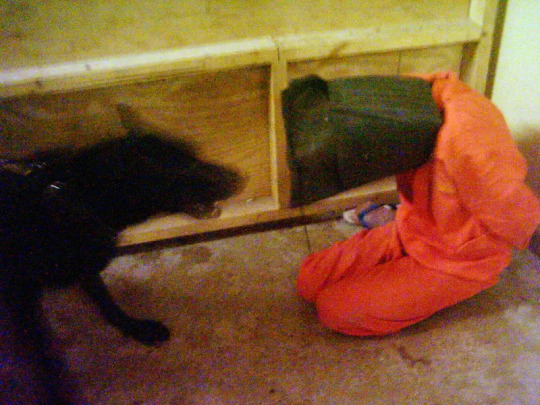
In May 2004, then Secretary of Defense Donald Rumsfeld addressed Congress. The abuse of detainees at Abu Ghraib "was inconsistent with the values of our nation," Rumsfeld said. "It was certainly fundamentally un-American."
Yet the use of attack-trained dogs at Abu Ghraib appears to have been imported from the United States. A 2005 report from the Department of Justice's inspector general scrutinized the private contractors who helped to build and run Abu Ghraib, detailing the backgrounds of the eight corrections experts who selected the site, oversaw the rebuilding of the prison, and trained staff at Abu Ghraib: Lane McCotter, Gary DeLand, Terry Bartlett, Richard Billings, Larry DuBois, John Armstrong, Terry Stewart, and Charles Ryan. Each had been a high-level state prison administrator or corrections commissioner before arriving in Baghdad.
All eight, Insider has found, previously started, expanded, or administered programs at US prisons that authorized the use of dogs to attack and intimidate incarcerated people. McCotter in New Mexico and Utah; DeLand, Billings, and Bartlett in Utah; Ryan and Stewart in Arizona; DuBois in Massachusetts; and Armstrong in Connecticut.
Two decades after the human-rights abuses unfolded at Abu Ghraib, almost all of these state prison systems continue to use unmuzzled attack-trained dogs. Insider has identified 12 states that authorize their use against people in state custody. At least 23 prisons in eight states have deployed attack-trained dogs on prisoners in recent years — Arizona, Connecticut, Delaware, Indiana, Iowa, Massachusetts, New Jersey, and Virginia. Over the past six years, hundreds of incarcerated people have been bitten or mauled.
Human Rights Watch researchers wrote, in 2006, that they were unaware of a single other prison system in the world that used dogs to attack people in the confined space of a cell.
The path to Abu Ghraib
A Department of Justice report named the private contractors hired by the United States as correctional consultants in Iraq. All eight were previously associated with patrol dog programs in US prisons.
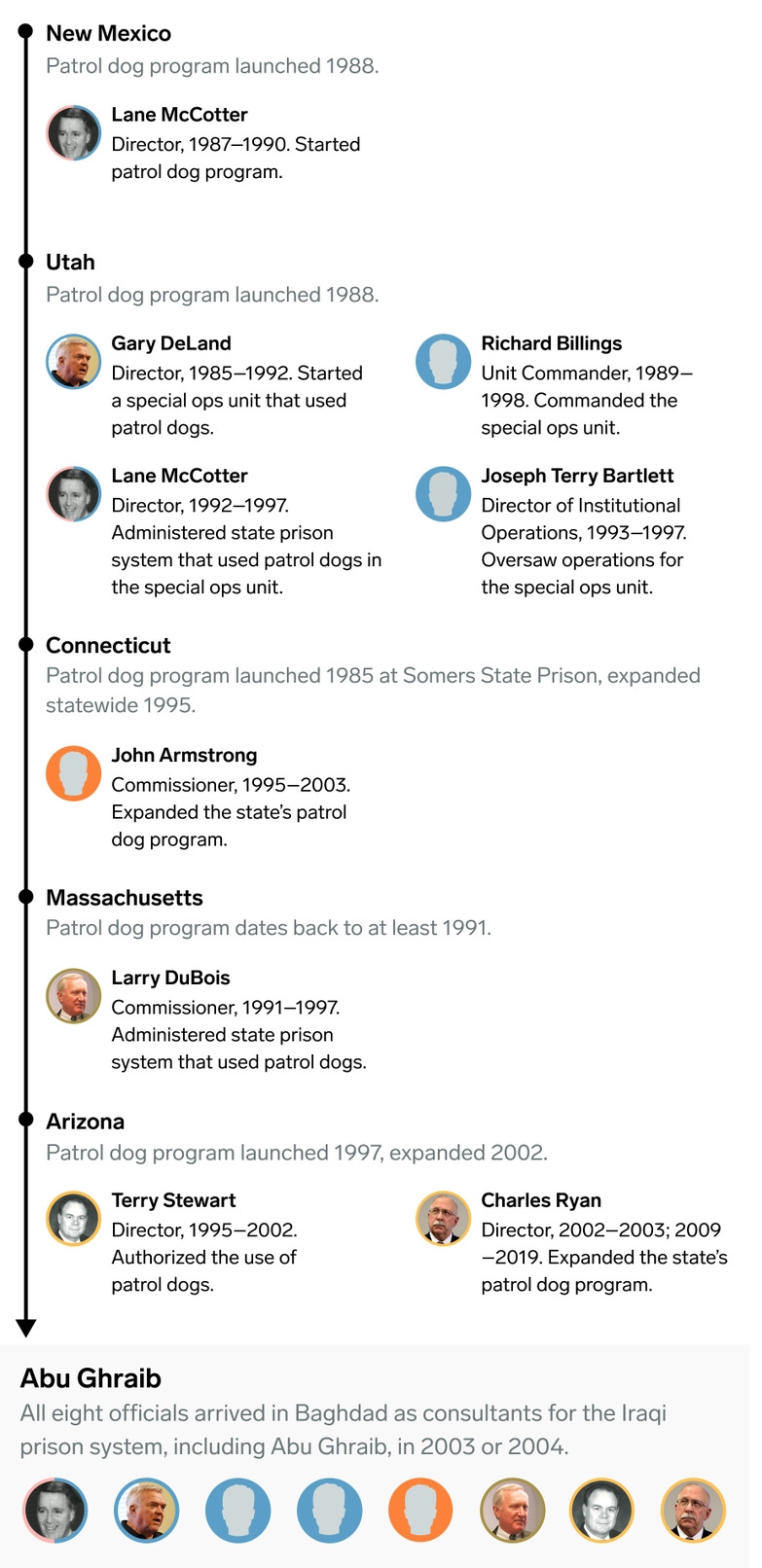
Source: Department of Justice; legislative reports; state departments of correction; news reports.
Alexandria, Virginia
When Adrian Duran was 10 years old, a neighbor at the end of his cul-de-sac in Alexandria, Virginia, gave him a black pit-bull puppy. He cradled him, squirming and warm, under his shirt and carried him home, smuggling him through the back door of his mother's house and down the stairs into the basement where he planned to keep him hidden in the laundry room.
His mother discovered the puppy shortly after and, furious, told Duran he'd have to sleep with the dog in the basement. So Duran curled up on a pile of blankets on the floor and held the puppy's soft, solid weight on his chest as he fell asleep each night. He called him Blackie.

Every day after school, Duran would run home, bolt down the basement stairs, and open the door to the laundry room where Blackie waited for him, yipping in excitement. His mother worked late, so Duran would take Blackie into the streets with him, visiting friends and neighbors and meeting up with older kids in backyards and garages, and on street corners. He tied his blue bandana around the puppy's neck.
Blackie grew into a large, heavily muscled pit bull. When Duran was threatened by other kids, Blackie squared off by his side and growled. Duran bought Blackie a spiked collar and took him everywhere; Blackie became Duran's protector and his most devoted friend.
At around 14, Duran started hustling. He joined a gang and started stealing — first small things, then cars. His mother told Duran that if he got arrested, she would be forced to put Blackie out in the street. Duran loved his dog too much to face that risk. Gutted, he left Blackie with a neighbor who promised to care for him.
Months later, Duran was arrested for driving a stolen car across state lines. In 2008, he pleaded guilty to an assault and got 15 years. By age 18, he'd been transferred to Sussex I State Prison.
There, his relationship to dogs shifted. It felt as if patrol dogs were everywhere, barking and snarling, lunging on their leads just feet away as the men walked between prison buildings. He couldn't escape them. Their near-constant barking echoed and amplified against the concrete and steel of his cell. At 19, he saw one attack a man for the first time. The man's screams nearly obliterated his memories of Blackie.
Duran witnessed 10 more vicious attacks over the next 10 years, experiences so terrifying that he structured his days to avoid the dogs at all costs.
Then he was brutally attacked himself.
The Virginia Department of Corrections
Police departments have long employed trained attack dogs to supplement the range and speed of officers in the field. But prison patrol dogs aren't deployed for chases; they are used inside the prison walls. In these tight, enclosed spaces, the aggressive barking and threat of attack terrorize people trapped inside razor-wire fences and cell doors. The use of dogs to attack people in the confined space of a prison cell has been described by Human Rights Watch as a "well-kept secret" — and a human-rights violation. The dogs' presence inside prisons, the organization found, "is intended to terrify and intimidate."
Even witnessing a dog attack in close quarters is harrowing. One former Virginia corrections officer said watching a dog attack a person, hearing their screams and desperate pleas and seeing all that blood, was a "primal" experience and deeply traumatizing. "It's just not something you forget," he said.
For those who are the intended target of the intimidation, witnessing a dog attack is devastating, multiple men told Insider. Many suffer nightmares, intrusive thoughts, and fear for weeks and months after seeing an attack. For the hundreds of men who are bitten or mauled themselves, the physical and emotional impact can last for years.
Through public-records requests, court documents, medical records, and interviews with dozens of bite victims, Insider documented at least 295 incidents where attack-trained dogs bit incarcerated people over the six years from 2017 to 2022. Insider identified one attack in Connecticut, to break up a fight in 2020; three in Massachusetts, all in the context of forced cell extractions, in 2020; five in Indiana; 15 in Arizona; and 271 attacks in Virginia.
The locations of the bites indicate that many of the men may have been prone when they were attacked; a 2006 study suggested that bites to the head, neck, and torso are more likely when the target is on the ground, hiding, or partially restrained.
Several men described being cuffed or compliant, spread-eagled on the ground, when attacked; one incident report from July 2022 documents that a man in a Virginia facility called Sussex II State Prison was attacked by a patrol dog after he'd been wrestled into leg irons.
The bites are severe, sometimes permanently disabling and disfiguring. Dozens of people said the terror of being attacked by a dog caused them acute distress, such as recurring nightmares or other symptoms of post-traumatic stress disorder. The process of being conditioned to such extreme violence leaves many of the dogs in a state of intense distress themselves. More than one has bitten off his own tail.
State prison systems that employ attack-trained dogs say their use makes facilities safer for those who are incarcerated and those who guard them. Departments argue that the presence of the dogs alone — their barking and snarling — is so intimidating that it deters many violent incidents from taking place. When employed as a use of force, prison administrators say, the dogs replace corrections officers in dangerous situations like breaking up violent fights or forcibly removing a person from their cell, a tactic known as a cell extraction. Yet no studies have established the efficacy of using attack dogs in correctional settings, and records reveal they are deployed differently by each state that uses them.
In Arizona, the department's dogs are trained to search for narcotics and contraband and to attack on command, and they are kept muzzled except when they're being deployed to bite. In Indiana, they're used to detect contraband, but also to patrol perimeters and apprehend escapees. Massachusetts requires wardens to seek permission from the state corrections commissioner every time they bring attack-trained dogs inside a prison facility, and they're approved only for "major disorders" such as cell extractions. In Iowa, patrol dogs are authorized to bite, but over six years from 2016 to 2021, patrol dogs never bit a single prisoner, despite being present at 19 cell extractions, according to records Insider obtained through a public-records request.
The Virginia Department of Corrections is an extreme outlier, commanding dogs to attack on an unmatched scale. Records show that Virginia prisons deploy patrol dogs to attack incarcerated people as a routine use of force in the state's six high-security prisons: Keen Mountain, Sussex I, Sussex II, Wallens Ridge, River North, and Red Onion. Insider documented one additional attack at Augusta, a medium-security facility. In a court filing, the department said roughly one in every seven deployments resulted in attacks. Insider was able to document 271 attacks in Virginia state prisons from 2017 to 2022, through court filings and internal incident reports. Through a legal settlement with the state department of corrections over a public-records request, Insider and the University of Virginia School of Law First Amendment Clinic obtained bite reports for 149 of these attacks.
The severity of the wounds caused by the attacks betrays the tremendous force the dogs can wield. Medical records obtained by Insider contain evidence of deep puncture wounds, lacerations with torn edges, and crush injuries in which muscle, nerves, and bones were damaged from the pressure of the dog's jaw. A study using data from the 1980s and 1990s in Los Angeles found bites from attack-trained dogs were more medically serious than bites from domestic pet dogs. The authors found people bitten by trained law-enforcement dogs were more likely to be hospitalized and require surgeries for skin grafts or tendon and arterial repairs. Dog mouths are also loaded with bacteria. A 1994 dog-bite study found a correlation between the depth of the bite and an increased risk of developing serious infections.
In at least 18 incidents, bite victims in Virginia were wounded so severely by attack-trained dogs that they were transferred to nearby hospitals to be treated for crush injuries, extensive muscle and tissue damage, or septic infections. Others were found to have symptoms of trauma.
A patrol dog named Jerko attacked Jeremy Defour at Sussex II in 2018, biting and tearing his buttocks and genitals, according to court records. The attack went on for a full minute as he lay prone, while he begged for the handler to pull off the dog. He was later diagnosed with PTSD.
Bert, a patrol dog at Wallens Ridge State Prison, bit Antwon Whitten seven times across his back, shoulders, head, face, and hands during a cell extraction in 2015, according to court filings and internal incident reports. Multiple lacerations split his face from the corner of his nostril to his jawline. Healthcare workers stitched his bite wounds with 55 internal and external sutures, according to his medical paperwork.
Bite locations indicate men may have been prone when attacked
An analysis of Virginia patrol dog bites from 2017 to 2022 shows bites to the head, neck, and torso. One study said such bites are more likely when a target is on the ground, hiding, or partially restrained.
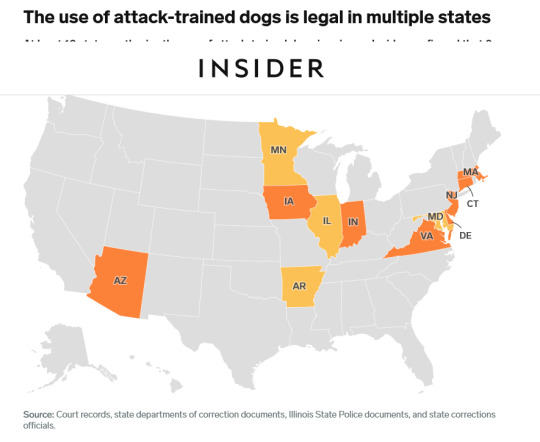
Source: Federal court filings, medical records, Virginia Department of Corrections internal incident reports, "Police and domestic dog bite injuries: What are the differences? What are the implications about police dog use?," Injury Extra, May 2, 2006, by Peter C. Meade, Kern Medical Center.
In response to Insider's findings, a spokesperson for the Arizona Department of Corrections, Rehabilitation, and Reentry said the department was under new leadership and would be reviewing all of its policies and practices, including its use of dogs.
Other departments defended their current protocols. The Indiana Department of Correction said all its dogs were trained "using the appropriate K9 industry standards." The Delaware Department of Correction said department dogs "assist officers in meeting their safety and security mission." A spokesperson for the Virginia Department of Corrections said the department's use of patrol dogs was governed by operation procedures authorized by Virginia law.
Though Insider documented three dog attacks in Massachusetts in 2020, a spokesperson for the state department of corrections said patrol dogs were deployed only to intimidate and "do not engage in use of force tactics." The department, the spokesperson said, "remains committed to de-escalation." New Jersey deployed patrol dogs at least once in recent years, according to court filings — to "restore order" at South Woods State Prison in April 2020. A spokesperson for the New Jersey Department of Corrections said the department's use of patrol dogs conforms to state guidelines on use of force and that no patrol dog had bitten an incarcerated person "in more than a decade."
Departments of corrections in Iowa and Connecticut did not respond to queries.
Tri-State Canines training facility, Warren, Ohio
Virginia Department of Corrections patrol dogs are typically Belgian Malinois, Czech shepherds, or German shepherds. These breeds were once developed for herding but now dominate the ranks of military and law-enforcement canines because they are intelligent, robust, energetic working dogs with a deeply encoded instinct to protect.
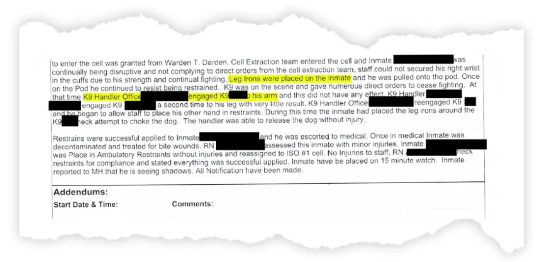
An attack dog's bite is powerful enough to puncture sheet metal. On people, the bites rend skin and muscle. Department patrol dogs are trained to bite once and hold to minimize flesh tears and lacerations. However, in nearly 30% of the bite reports Insider analyzed, Virginia patrol dogs bit more than once or "readjusted" their bites to different body parts in response to a victim fighting or thrashing in pain. The dogs bit arms and legs most commonly but also bit stomachs, faces, hands, feet, hips, shoulders, and genitals. In at least 15 cases over the past six years, Virginia dogs mauled people all over their bodies, biting them three, four, or even six times and leaving wounds on their arms, legs, shoulders, faces, chests, and hands.
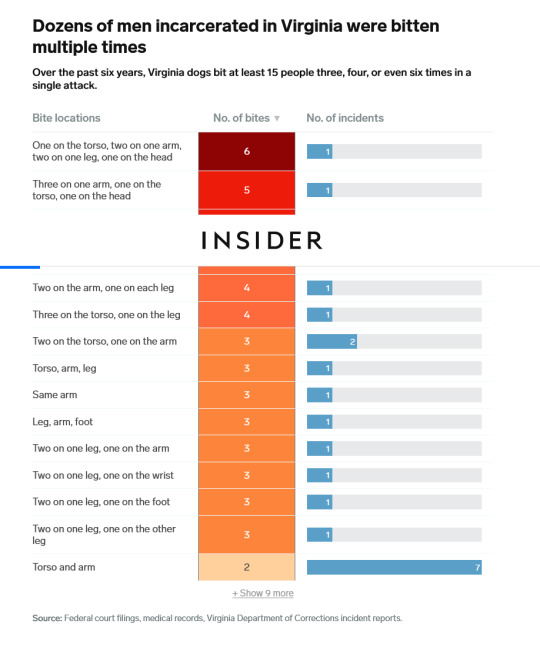
Most attack-trained law-enforcement dogs are bred in central, eastern, and northern Europe where there's a long tradition of training dogs from puppyhood to compete in elite patrol-dog competitions. In these competitions, dogs score points for tracking, obedience, and "protection" — attacking a person in a bite suit on command. The training methods used by some competition hobbyists are notoriously cruel. Videos released by Oikeutta eläimille, a Finnish animal-rights organization, show German trainers beating, kicking, and using electric and prong collars to shock and suffocate their dogs until they yelp in pain.
When these dogs retire from competition, some are sold to American importers like Dave Blosser, the owner of Tri-State Canine Services, a company that sources and trains dogs for US law-enforcement agencies and prison and jail systems. A retired police-dog handler himself, Blosser travels to Europe in search of dogs who possess what trainers call "drive," a potent combination of ferocity, intense energy, desire to work, and aggression.
"We're not looking for Fluffy," Blosser said. "My dog would take down Satan."
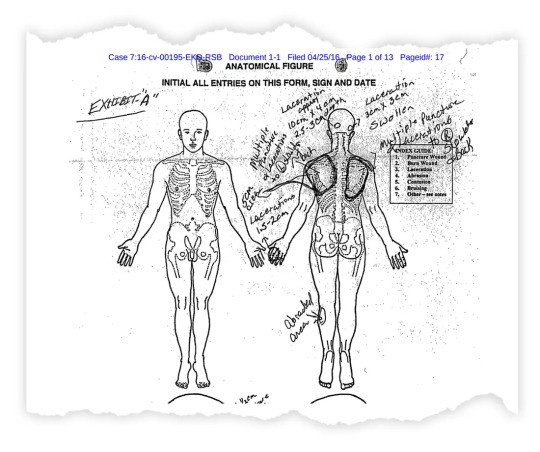
He imports the dogs to his training facility, a converted warehouse in Warren, Ohio. Some of the dogs arrive "hard," too aggressive to handle after getting their "ass kicked over in Holland," Blosser said. He sometimes deprives the most reactive dogs of food and water for a few days. Once they stop fighting him, he begins to train them for their new job: searching for narcotics, chasing a fleeing suspect, or attacking a human being on command.
One day last July, Blosser demonstrated how he conditions a dog to respond to threats with aggression. He led a Belgian Malinois up onto a small plywood table at his training facility and chained him to a metal pole. The handler and other trainers yelled, struck the concrete flooring with cloth bullwhips, and threatened the dog with padded wooden poles until he was defensive and agitated. He barked, a sharp clanging sound that echoed off the cinder-block walls. They continued until the dog was intensely aroused, slavering and chomping. Blosser then approached wearing a padded bite sleeve and pressed the dog's boundaries until he attacked, biting the canvas and jerking his head sharply back and forth.
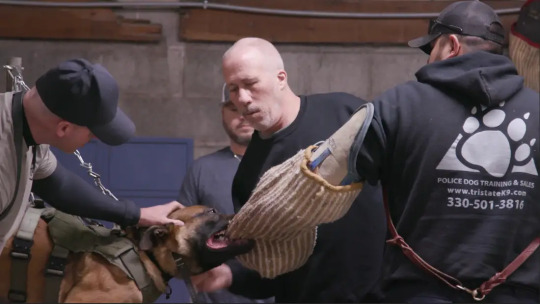
Later that day, Blosser headed to an abandoned elementary school outside Canton, Ohio, where he conducts more advanced training sessions. He sent a volunteer decoy wearing a 35-pound padded bite suit to stand in the corner of a classroom. The suit reeked of sweat and dog mouth, and the dog could smell it from yards away. He panted in anticipation.
As the dog and his handler burst into the classroom, the handler shouted a sharp "stellen" — the German command for bite. The dog lunged forward and up toward the decoy's chest, biting the suit on his arm just above the elbow. The dog held the bite, dragging his weight against the decoy. The man screamed and thrashed to simulate a victim in pain.
These exercises focus on building aggression and confidence, Blosser said. He wants the dogs to "dominate the guy, knock the guy down." Teaching control comes later.
"If you apply too much brake in the beginning, you shut the dog down," he said.
When a dog's senses are flooded with novel stimuli — the smell of fear hormones and real panicked screams — even a well-trained canine might balk and refuse to attack. You won't know how a dog will really react, Blosser said, until he's been "blooded" on a first bite in the field.
Blosser flipped through dozens of photos of dog bites on his phone. Trainers and law-enforcement canine handlers send them to one another, he said, like trading cards. He identifies one woman, her eyes red from crying and arm littered with bite wounds, as a pet-shop assistant who tried to help put a new vest on a police dog. Another shows a canine trainer like himself, his neck gashed open from a dog's tooth that split his skin from throat to ear.
Patrol school, Wallens Ridge State Prison
Matthew Johnson, a former Virginia canine officer at Wallens Ridge, picked out his last patrol-dog partner personally from a purveyor like Blosser in Connecticut, a massive German shepherd with a giant, jug-like head named Oscar. Johnson put his fingers through the metal loops of the kennel fencing and Oscar growled at him immediately. That's the one, he thought.
When Johnson first began training Oscar, the dog whipped around and bit Johnson on the arm, leaving a pair of scars that mangled one of the four horsemen on his forearm tattoo. Stitches still fresh, Johnson returned the next day to work with Oscar, thrilled.
"A dog that'll bite a handler will bite an inmate," he said.
Once Johnson managed to gain control of Oscar, the pair was assigned to Wallens Ridge in 2018. Oscar was a smart dog, Johnson said, and strong — difficult to physically handle. When Oscar would hear "10-18" over the radio, the call sign used to report a fight, he'd race toward the pod doors. He was "hard," Johnson said; he bit with more strength and ferocity than any other dog Johnson had ever handled.
That same year, Boris, a 92-pound German shepherd, went through patrol school and was assigned to his first handler in June at Wallens Ridge. A year earlier, a patrol dog named Cajos was trained, certified, and sent to Sussex I.
A-5 Pod, Red Onion State Prison
In 2017, Duran lay on the top bunk in his cell at Red Onion State Prison.
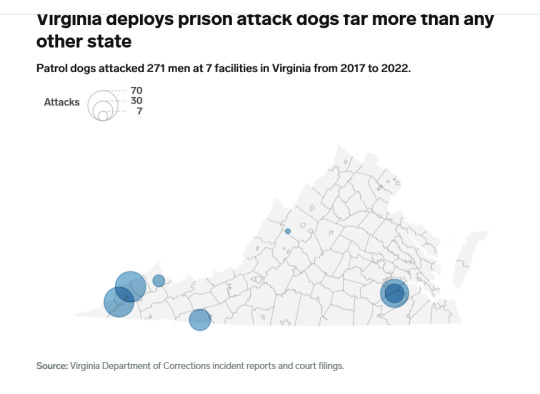
He heard shouts as a fight broke out on the top tier of the 44-cell pod and the quick blasts of officers firing less-lethal rounds. At Red Onion, these are typically "pepper balls" — plastic bullets filled with pepper spray.
Two men ran into Duran's cell and dived onto the floor, as Duran heard the barking of dogs from his upper bunk. An alarm sounded and the cell doors began to slide shut for lockdown. A fourth man scrambled madly at the door, trying to drag his torso through into the cell. He was too late. A patrol dog clamped its teeth around the man's lower leg and dragged him out of the cell, screaming.
Of the 149 bite reports Insider obtained from the Virginia Department of Corrections, there were six reports of bites from 2017 at Red Onion. Only one closely matches the circumstances described by Duran: the March 15, 2017, attack on Linwood Mathias.
The report is spare. "Canine [redacted] engaged offender [redacted] on the lower left leg in the calf area," the handler writes.

This is what Mathias remembers: being shot at with less-lethal rounds before he dropped to the floor by the cell door, face down, arms outstretched. Feeling teeth like an alligator's bite down on his lower leg. The dog pulling him out of the cell and into the common area, thrashing its head side to side. The dog's teeth tearing into his skin and muscle.
The dog releasing only to bite his calf a second time. His own screams. The moment he stopped screaming and lay still. The way his lower leg looked like ground beef.
Duran likely witnessed all of this more than two years before he was attacked himself.
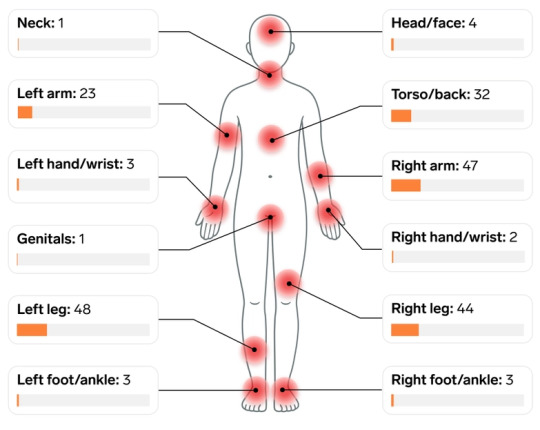
An ambulance took Mathias to Mountain View Regional Hospital in Norton, Virginia, a half-hour drive away from the prison, where he stayed for 13 days. He required 42 stitches and three surgeries over 11 days to clean and debride the wound for infections that left his leg red and swollen from calf to groin.
Mathias first used a wheelchair, then a walker. He spent months in painful physical therapy. But the crush of the bite left his calf muscle permanently frozen. Years later, at his home in Portsmouth, Virginia, he still uses a cane on days when his leg swells and aches with severe nerve pain.
He now lives with intrusive memories that won't let him go. The searing pain of the attack, the revolting feeling of the dog's teeth in his leg. He also can't shake the memory of the canine handler yelling racial slurs as the dog attacked. "Get 'em, boy!" he yelled. "Get that n—."
Later, when he returned to Red Onion
from the hospital, Mathias remembers, another corrections officer said, "I wish I could tie you to my bumper and drag you down the street."
A third officer told him, "We wish you lived out there, so we could shoot you like deer."
'White man's country'
Mathias was one of seven Black men attacked by prison dogs in Virginia prisons from 2011 to 2022 who allege in court filings or in interviews with Insider that corrections officers yelled racial slurs or taunts during or immediately after the attacks.
Xavia Goodwyn said in a civil complaint that a corrections officer used racist epithets as he was being attacked by a dog called Lojzo at Red Onion in 2015. As the canine officer sicced Lojzo on him, he said in an interview, the other officer held him down and repeatedly called him a "n—." Four other Black men attacked by dogs in recent years at Wallens Ridge, River North, and Red Onion said in court filings or in interviews that officers hurled the N-word at them as a patrol dog was biting into their flesh.

When Michael Watson got into a fight at Red Onion in 2020, he was shot twice with less-lethal rounds before a patrol dog clamped into his back and buttocks for "60 to 90 seconds," according to an affidavit. The handler later visited Watson while he was receiving treatment for his wounds in the prison medical clinic. "My dog got you good," Watson recalled the handler saying as he laughed. "He loves dark meat."
After Thomas Rose was shot with a less-lethal round and blasted with pepper spray after being attacked by another man at River North Correctional Center in 2020, incident reports show, a dog named Tom bit him on his right leg so severely that his shoe filled with blood. As he stumbled toward the medical office, he later alleged in a civil complaint, he heard a mocking taunt from a corrections officer: "Black lives matter."
Corrections officers denied the allegations of racism against Goodwyn and Rose in separate court filings. Officers did not respond to Watson's allegations because he made them in an affidavit supporting another, unsuccessful, civil complaint.
Rose and Goodwyn each lost their cases at bench trials when judges said they had failed to prove that the attacks violated the constitutional protection against "cruel and unusual punishment" enshrined in the Eighth Amendment. The judge in Rose's case found that the officers had issued warnings and that the dog was not used "maliciously or sadistically" — the legal standard required to find an Eighth Amendment violation — "but, rather, in a good faith effort to restore order." In Rose's grievance file, obtained by Insider, the department found "no violation of procedure" in the attack.
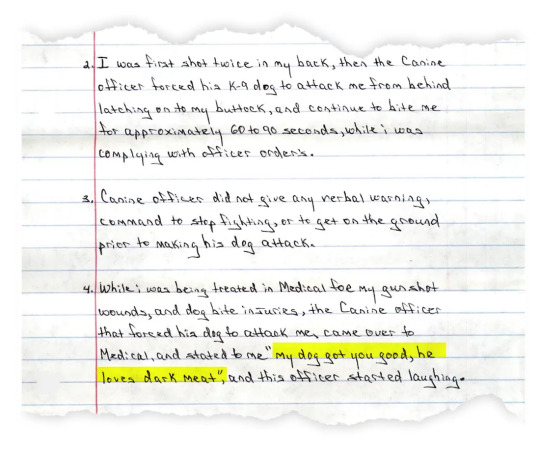
When asked about the allegations of racial violence, Rick White, who has served as warden at Red Onion since 2021, said he was not aware of any situations in which officers had used racist language. The Virginia Department of Corrections did not respond to Insider's questions about individual cases.
Red Onion and Wallens Ridge prisons, in deep rural Virginia near the Kentucky border, have each been repeatedly investigated for allegations of racism by prison staff. Human Rights Watch found in 1999 that Red Onion guards routinely subjected Black prisoners to racial slurs, taunts, and physical threats. In 2000, the FBI opened an investigation into Wallens Ridge after 108 prisoners transferred there from New Mexico filed civil-rights lawsuits alleging they were subject to racist taunts and epithets. One attorney said a guard had threatened to turn prisoners over to the Ku Klux Klan.
Virginia Department of Corrections officials responded to the Human Rights Watch report by calling it "biased and inaccurate." In 2000, Ron Angelone, then director of the Virginia Department of Corrections, called the allegations of racism and excessive force at Wallens Ridge and Red Onion "lies from convicted felons who don't like being locked up in tough prisons."
The following year, in 2001, the Connecticut Commission on Human Rights and Opportunities, a government agency charged with enforcing the state's anti-discrimination laws, also investigated Wallens Ridge, as a number of Connecticut prisoners were contracted to be housed there. The commission's report found that Connecticut prisoners there had been called racist slurs, shot at with rubber bullets, and taunted with songs about lynching.
"Yo, Black boy, you in the wrong place," a prisoner cited in the report recounts a guard saying. "This is white man's country."
Birmingham, Alabama, 1963
Dogs have a long history of being deployed to terrify and attack Black and Indigenous people in the United States. Tyler Parry, an assistant professor of African American and African diaspora studies at the University of Nevada at Las Vegas, and Charlton Yingling, an assistant professor of history at the University of Louisville, study the history of weaponized dogs in the Americas. Attack-trained dogs have helped violently enforce white supremacy, Parry said, from executing indigenous Taino people in the Caribbean, to hunting down those who tried to escape slavery in the American South, to attacking civil-rights protesters in the 1960s.
"The dog has always been intended to strike a certain fear amongst the person that's detained or oppressed," Parry said. He called their use a form of "racialized terror."
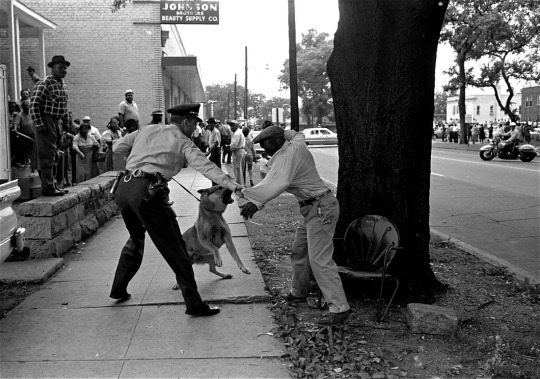
Many slaveholders believed that dogs could sense race, Parry said, that they could be specifically trained to hunt for the scent of Black bodies. Breeders honed these so-called "negro dogs" as manhunters, selecting for sense of smell, strength, tenacity, and aggression to hunt, run down, and sometimes execute people fleeing slavery. By the 1840s, these dogs were commonplace throughout the United States, Parry and Yingling found.
In his 1853 memoir, "Twelve Years a Slave," Solomon Northup describes his pursuit by dogs during an escape attempt. "Each moment I expected they would spring upon my back — expected to feel their long teeth sinking into my flesh," Solomon recounted. "There were so many of them, I knew they would tear me to pieces, that they would worry me, at once, to death."
A century later, in May 1963, when thousands of Black children poured into the streets of Birmingham, Alabama, to join the protests against segregation, the city's notorious police commissioner, Eugene "Bull" Connor, met them with force. He ordered white officers to point fire hoses at the protesters and to sic German shepherds on the young students. In one photo, captured by Bill Hudson, a white police officer grabs Walter Gadsden, a 15-year-old high-school student, as a German shepherd lunges, teeth bared, at Gadsden's torso.
"A hundred years ago they used to put on a white sheet and use a bloodhound against Negroes," Malcolm X said in an interview not long after the protests. "Today they have taken off the white sheet and put on police uniforms and traded in the bloodhounds for police dogs."
After the brutal crackdown on people protesting the killing of Michael Brown by a police officer in Ferguson, Missouri, a half a century later, the Department of Justice investigated the Ferguson Police Department and found a range of civil-rights abuses. These included the excessive use of dogs to attack people, including children, in routine police encounters. In every case where racial information was available, Ferguson police officers had sicced their dogs on Black people.
Officers, the report found, "appear to use canines not to counter a physical threat but to inflict punishment."
Cell 15, P-2 Housing Unit, Souza-Baranowski Correctional Center
There are more than 370 maximum-security prisons in the United States, and the overwhelming majority do not use attack dogs at all.
Yet in Virginia, attack dogs are used, in the words of one corrections department court filing, as a "manpower multiplier" and routinely patrol most areas of the prison. They're a frequent sight in the general population housing units, called pods, that are divided into two 22-cell horseshoes stacked two tiers high; along the concrete pathways, called boulevards, that lead from the residency buildings to the chow hall, classrooms, and visitation rooms; and at the boundaries of the fenced-in recreation yards.

Rick White, the Red Onion warden, told Insider the dogs were primarily used for "presence" — in other words, that the implied violence of their growls and bared teeth is sufficient to frighten people into compliance. He said the canine program has created a safe environment, allowing Red Onion to provide group educational and religious programs. While Insider documented three attacks at Red Onion in 2022, White said dogs were deployed for "presence" more than 200 times that year.
Three former department employees confirmed to Insider that they're used primarily for deterrence. But according to an internal department record submitted in a court filing, dogs were deployed in Virginia to attack prisoners about four times a month, on average, from April 2016 to June 2022. Incident reports record patrol dogs being commanded to attack when prisoners do not immediately comply with orders from corrections officers, when prisoners are fighting, or for cell extractions.
When a man refuses to leave his cell, Virginia canine handlers are authorized to send in their dogs to bite him until he complies. On Christmas Day 2018, in Sussex I, Curtis Garrett ran away from corrections officers breaking up a fight and barricaded himself in his cell. Two dogs, Hurricane and Lojzo, and their handlers were sent in to extract him. In the process, the dogs badly mauled Garrett on his arms and legs, according to a civil complaint. An attorney representing the department later argued to a judge that it was necessary to sic the dogs on Garrett to prevent him from harming himself.

Kathleen Dennehy became a corrections commissioner for the Commonwealth of Massachusetts in 2004, a period when the state allowed the use of attack dogs. Dennehy, who left that post in 2007 and now serves as a corrections consultant, quickly emerged as a critic of the use of attack-trained dogs in prison settings. "A dog going into a cell for the purpose of disarming someone or forcing compliance, to me, is a human-rights violation," she said. "The potential is there to do some serious injury."
Cell extractions are necessary only when someone is threatening to harm themselves or others, Dennehy explained. In those cases, she said, the best evidence-based practice is to deploy a dedicated health worker and a specially trained team of corrections officers who are properly outfitted with body armor, shields, and body cameras to enter the cell and wrestle the person out using as little force as possible.
Dennehy acknowledged that prisons are tinderboxes, and that any small altercation can quickly explode into violence. In these cases, she said, de-escalation is the priority. If force is required, it should be the minimum force necessary — pepper spray, for example — to ensure prisoner and staff safety.
"You don't go into a situation thinking you're going to escalate it and use the maximum force to resolve it quickly," Dennehy said. "The goal is to try to use the minimal amount."
But a dog cannot be trained to bite with the minimum necessary force, Jimmy Stanley, the canine sergeant at Red Onion from 2012 to 2021, said last year in a deposition. Their bites cannot be checked, only directed.

Dora Schriro, the director of the Arizona Department of Corrections, Rehabilitation, and Reentry from 2003 to 2009, discontinued using attack-trained patrol dogs in Arizona prisons in 2006. "The idea that you would have to revert to the dog, particularly one that's trained to attack, is beyond extreme," she said.
Dennehy banned the use of dogs to bite prisoners in Massachusetts state prisons that same year. "I didn't see any instances where we should be sending dogs in to potentially rip flesh off of inmates," she said.
Yet after Schriro and Dennehy left their jobs, both departments reintroduced the use of attack-trained dogs.
In January 2020, over 10 years after dogs were reintroduced in Massachusetts prisons, a patrol dog at Souza-Baranowski Correctional Center called Omar bit Dionisio Paulino during a cell extraction, tearing off a "chunk of his upper thigh," according to a civil complaint and incident reports. In the complaint, Paulino and his cellmate, Robert Silva-Prentice, allege the attack on Paulino was part of a retaliatory campaign in response to an earlier incident in which prisoners had injured three officers. The guards, they allege, used beatings, dogs, Tasers, and pepper spray "to instill a sense of terror and fear of future retaliatory attacks on Black and Latino prisoners."
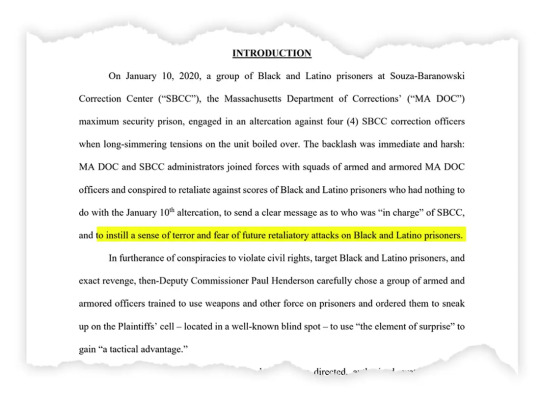
Prison officials said in court filings that the force deployed in January 2020 was necessary to maintain facility security. They also denied that the use of force was retaliatory or excessive. The case is pending.
In May 2023, court filings revealed the existence of a previously secret federal grand jury, which was investigating the bite inflicted on Paulino and other related allegations of brutality and retaliatory violence from prison guards. A federal review of the January 2020 incident could potentially result in federal criminal indictments against state officials for civil-rights violations. If charges are filed, civil-rights attorneys say, it could mark the first time federal criminal charges have been brought over an incident that involved the use of a dog to attack an incarcerated person.
Housing Unit 4, Sussex II State Prison
On September 4, 2019, a fight broke out on the upper tier of Adrian Duran's housing unit at Sussex II, incident reports show. The brawl involved at least a dozen people, including Duran. One of them hit Duran on the head, a blow that split his forehead near his right eyebrow; it bled badly, partially blinding him. In the chaos, he heard corrections officers arriving and fled down the stairs to the lower tier with several other men.
At the foot of the stairs, Duran ran his hands down his torso, checking for stab wounds, and tried to wipe the blood from his eyes. Then he heard a dog bark and a cold fear shot through his chest. A second later, a canine handler and her dog came screaming into the housing unit.
Duran spun and slammed himself chest down onto the floor — his feet toward the door, his head toward the stairs — facing the other prisoners who had also dropped to the floor. He glanced over his shoulder just as Cajos opened his mouth wide.
Cajos bit down on Duran's lower left calf above the ankle. He felt a spike of intense pain as the dog's teeth sank into his flesh, then a brutal pressure as Cajos crushed the muscle and bone of his leg between his jaws. Duran screamed so forcefully that flecks of blood and saliva hit the shocked face of the man on the floor in front of him.
The dog whiplashed his head from side to side. With each jerk, Duran felt his flesh tear in "cracking" splits as if someone powerful were forcing their fingers inside the punctures and ripping the wounds wider. He thrashed in panic and pain.
Duran begged the canine officer to remove her dog. She did briefly, then commanded Cajos to bite Duran a second time. He clamped down on the same leg, just below Duran's knee.

Duran felt detached. He couldn't scream anymore. The other men around him started to yell at the canine officer, desperately appealing to her to release the dog. Duran smelled a sharp metallic scent like copper pennies. It was the smell of his own blood spreading across the floor.
The canine officer pulled on the dog's lead, dragging both Cajos and Adrian backward on the floor until Cajos finally released the bite. Duran lay on the floor in shock, willing himself to lose consciousness. Corrections officers rolled him onto a stretcher and took him to medical where a nurse sent him for emergency treatment.
It wasn't until an emergency-department doctor unwound Duran's bloodied gauze bandages that he saw his own leg for the first time. Puncture wounds the size of nickels with jagged edges covered his lower left leg. Strips of flesh sagged away from his leg where lacerations had sliced through skin, fat, and muscle tissue.
When the doctor bent to examine the wound, she inhaled in shock.
"A dog did this to you?" she asked.
Virginia Commonwealth University Health, Richmond, Virginia
Prison officials sent Duran back to Sussex II less than 12 hours later. Officers pushed him in a wheelchair, following a trail of his own dried blood down the concrete boulevard from the prison exit to the front doors of the residence building, and then straight to a segregation cell.
The cell was filthy, its walls plastered with old food, dirt, and human excrement. Duran lay on the metal bed in dim fluorescent lighting. He tried to keep his wounds protected in the laundered bed sheets. And he wondered whether it would be safe to take a shower, since the water at Sussex II always ran a dull rust brown. Despite Tylenol and Codeine, his leg ached ferociously. He couldn't sleep.
A week and a half later a fever set in. His leg was severely inflamed — swollen, red, and hot to touch. His medical records show that he was prescribed antibiotics, but he said they were never dispensed. A nurse came to check on his fever, Duran said, and immediately ordered him sent for more emergency care. For four days Duran was treated at Virginia Commonwealth University Health for sepsis, a potentially fatal systemic infection, according to his medical paperwork.
Segregated Housing Unit, Red Onion State Prison
After Duran returned for the second time to Sussex II, his life in prison changed. He dropped out of his GED course to avoid passing the dogs barking and lunging in the yard on the way to his classroom. He had intrusive daydreams that the dogs might break their leads and chase him down the boulevard. He woke often in the middle of the night, drenched in sweat.
In one recurring dream, he hits the ground running, the dogs at his heels. He's fast; they're faster. He can't outrun them. At a full sprint he slams into a chain-link fence and tries to haul his weight up and over to safety. Teeth close around his lower left leg. Desperate, he claws at the metal loops, straining against the dog's weight. He can't hold on; his fingers slip. As the dogs rip him off the fence, his body jolts awake.
The dream is now as familiar as the cold fluorescent light of his cell.
Dozens of other incarcerated people bitten by patrol dogs say the attacks severely damaged their mental health. Many suffer from panic attacks, anxiety, nightmares, and depression. Some have been diagnosed with PTSD months and years after the attack, according to psychiatric and mental-health treatment records submitted in court filings.
Antwon Whitten was bitten on his head, face, arm, and shoulder at Wallens Ridge in 2015 by a dog named Bert. He wrote on a mental-health request form submitted in court filings that he was struggling to come to grips with his heavy facial scarring; he was experiencing depression and nightmares. "All day long while awake I can visualize that attack," he wrote.
Curtis Garrett, the man attacked by two dogs in a Sussex I cell extraction, said in a January 2021 court filing that he had suffered relentless nightmares, anxiety, and symptoms of PTSD. He was institutionalized in a state psychiatric hospital, his amended complaint says, for a mental breakdown caused by the trauma of the attack.
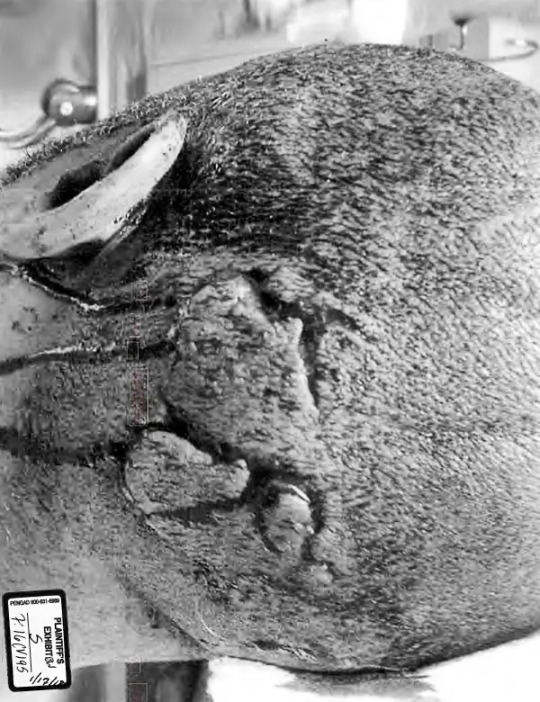
Jeremy Defour had such intense panic attacks and flashbacks after being attacked that he received a formal PTSD diagnosis. He was the one bitten by a patrol dog named Jerko on his buttocks and genitals at Sussex II. During that 2018 incident, he begged the canine officer to remove the dog. Instead, a second handler on the scene brought a barking dog right up to Defour's face, according to a complaint he filed in federal court. "Shut the fuck up," the handler said, "before I let my dog go too."
The emotional fallout from the incident was dramatic. Rather than encounter the dogs in general-population recreation yards and residence pods, Defour chose to spend the next three years in solitary confinement, pacing alone in an 8-foot-by-10-foot cell for 23 hours a day.
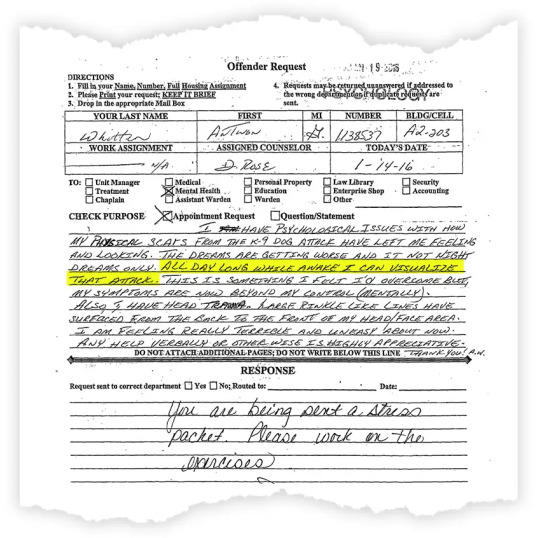
Whitten lost his case when a jury found that the attack was not malicious or sadistic; Garrett and Defour each eventually settled.
Patrol dog kennels, Virginia Department of Corrections
The patrol dog kennels are even smaller, at 6 feet by 10. The dogs run in compulsive circles around their enclosures, beating their tails against the chain-link fencing until they develop raw open sores.
The stress of the repeated attacks eventually breaks many of them.
"It's not natural anymore for a dog to bite a man," said Kenneth Licklider, the owner of Vohne Liche Kennels, in northern Indiana, which sources and trains dogs for law enforcement and for prisons and jails. Licklider, a military veteran, has also trained dogs for the US military, including dozens of explosive-detection dogs used by US troops in Iraq in 2004. He said a trainer must kindle a level of aggression in attack dogs "that went out of them in the stone age."
This requires pressure to a breaking point. Some patrol dogs begin to display compulsive behaviors and become destructive, cracking their own teeth chewing on concrete kennel walls and steel dog bowls. Others will attack themselves.
"This morning I had two canines bite the ends of their tails off," a Virginia canine program administrator wrote in a 2021 email.

Working dogs like patrol canines that are exposed to prolonged high-stress environments and traumatic violence can become avoidant or hyperreactive, veterinary behaviorists with expertise in canine aggression told Insider.
Incident reports and internal emails contain evidence of prison attack dogs rejecting their brutal assignment. A canine handler reported in 2018 that he tried to force his dog to bite a prisoner three times, but the dog "attempted to back out of his collar trying to get away." Chris Robbins, a Virginia patrol canine sergeant, wrote in a 2021 email that a dog called Rivan had refused to bite someone. He ended up sending Rivan back to patrol canine school to "build his aggression up."
At the Virginia patrol school, trainers build aggression by teaching dogs to "hate everyone but their handler," Matthew Johnson, the former canine officer, told Insider. The dogs cannot be touched, handled, or praised by anyone else.
A veterinary technician who treated patrol dogs at a clinic in Lebanon, Virginia, said she was told not to touch the patrol dogs in her care without their handler present. The technician, who asked not to be named, fearing retaliation, said she'd sometimes sneak a pet on a dog's nose pressed against the kennel door or push treats between the bars.
"They've experienced no kindness," she said. "No kindness whatsoever."
Some dogs become indiscriminately aggressive.
Southwest Virginia Veterinary Services, Lebanon, Virginia
On March 26, 2020, that same vet tech was called into the exam room to assist with a routine checkup for a patrol dog named Boris, a 92-pound German shepherd from Red Onion. Boris was muzzled but was in a state of visible agitation. He was foaming at the mouth and "extremely aggressive" toward the veterinarian and his own handler, Stephen McReynolds, according to an incident report.
McReynolds asked her and the veterinarian to leave the room. Through a slot in the closed door, the technician watched McReynolds pull Boris to the floor in an effort to get him under control as the dog fought to free himself, even trying to bite his handler through the muzzle. Eventually, McReynolds wrapped an arm around the dog's neck and pressed his other hand against the dog's chest. The technician heard Boris cry and struggle, then saw him lie still. McReynolds then called the vet tech and the veterinarian back into the room.
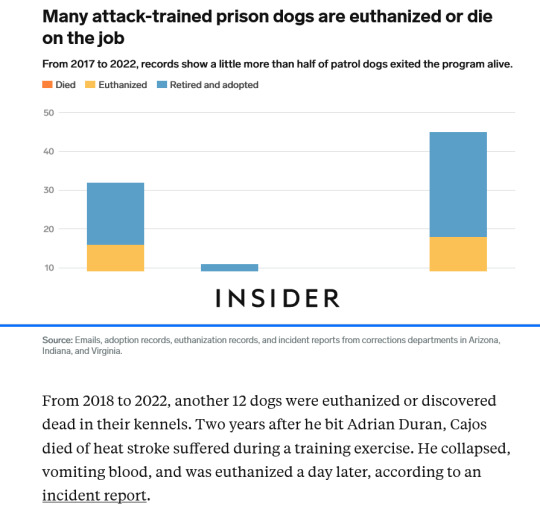
While McReynolds continued to hold Boris in a headlock, the technician said, she started to draw blood from the dog's back leg. Then she noticed Boris begin to urinate. She felt for a pulse and snapped at the handler to release him. Documents show the dog had stopped breathing. The veterinarian started CPR, but Boris was declared dead soon after.
McReynolds did not respond to queries; the Virginia Department of Corrections said it does not comment on personnel matters.
A necropsy report obtained by Insider found that Boris had died of "acute respiratory distress syndrome that resulted in cardiopulmonary arrest." Small purple spots found on the lung tissue included in the report suggested that blood clots had formed in his lungs because of the constriction of his airway, the technician explained.
"I was horrified," she said. "He killed that dog."
A backyard outside Waverly, Virginia
Due to their extreme reactivity, Virginia patrol dogs who are no longer suitable for work can be adopted only by a former handler, by department policy. This is their sole path to retirement.
Daniel Clinton, a former Virginia canine handler, adopted two of his former dog partners: first Tom, then Riko. Clinton kept the dogs in kennels in his backyard outside Waverly, Virginia, to give them time to decompress. He played with them outside with basketballs they'd pop between their curved teeth and let his kids carefully feed them kibble to teach him to trust them. Eventually, Tom became so docile, he said, "so ready to be loved, to be a pet," that he got to come inside. (Insider could not confirm whether he is the same Tom who bit Thomas Rose.) He would lay down on the living-room floor and delicately eat potato chips fed to him by Clinton's 6-year-old daughter.
Other adoptions are a struggle. Johnson, the former Virginia canine officer, adopted Fuga, a German-shepherd mix who was retired after he broke all four canine teeth on bites. Fuga remained so aggressive, Johnson said, that he had to keep the dog in a kennel in his backyard, surrounded by a 6-foot-high fence. If Fuga escaped, "the first thing he might do is bite a kid," Johnson said.
Some dogs are too dangerous to ever be adopted. In Virginia, four dogs were euthanized for aggression, destructive behavior, or liability risk in 2021 alone. The following year, another dog was euthanized after severely biting handlers at Wallens Ridge, Sussex I, and River North, according to an internal email and incident reports.
"I have tried to put him in a muzzle several times to work with him but it is nearly impossible," Chris Robbins, the Virginia patrol canine sergeant, wrote in an email on May 2, 2022. "We are going to keep having these issues," he wrote, "if we keep trying to rehabilitate him." The dog was euthanized three days later.
From 2018 to 2022, another 12 dogs were euthanized or discovered dead in their kennels. Two years after he bit Adrian Duran, Cajos died of heat stroke suffered during a training exercise. He collapsed, vomiting blood, and was euthanized a day later, according to an incident report.
Exterior, Red Onion State Prison
In the last year of his sentence, Duran, now 33, began to cautiously imagine his life outside.
He got married in January to Jamie Elliott, a former nurse at Sussex II. Elliott and Duran had gotten to know each other when she did medical calls on his pod; she quit her job in June 2021 when she realized she and Duran had feelings for each other. Like Duran, Elliott was scared of the patrol dogs, who often lunged and snapped at her, straining at their leads as she walked the boulevard between prison buildings. They felt to her like a constant reminder of how punitive and intimidating the prison was.

The couple wed in the Red Onion visitation room in front of the guard booth. Duran couldn't stop smiling. In their wedding photo, the two of them are posed against the blue wall of the prison's visitation room. Elliott loops her arms around him and hugs him close. Now they talk on the phone every day, about their families, Elliott's new nursing job, and ordinary details of her daily life outside. Occasionally they squabble over whether Duran will be able to tolerate the presence of Bodhi, Elliott's 12-year-old chihuahua, when he comes home to her.
Some days his future feels guaranteed. Elliott sends him pictures of the flowering crabapple trees in front of the exit doors of Red Onion, and he imagines walking past them the day he leaves. He imagines taking long walks in the mountains with no one else around. He imagines meeting his new nephew before the baby learns to walk.
Other days his leg aches, and when Jamie asks about his day he has nothing to say that won't frighten her.
Like the day last spring when Duran was in his cell on the top tier right at the moment Jawan Lee was returned to the pod from another residence hall. Boisterous and funny, with a quick smile and expressive hands, Lee took a spin around to greet everyone before walking up to his own top-tier cell, right by the stairs.
A group of corrections officers arrived with the lunch cart, according to a grievance document later filed by Lee, and began to release the men in clusters to retrieve their trays. Just as Lee walked out onto the stairs, another man ran out from an unsecured bottom tier cell and tackled him, pinning him on his back.
Lee fought back. A corrections officer sprayed Lee directly in the eyes and mouth with pepper spray. From his top tier cell, according to an affidavit he filed later, Duran watched a handler pull a patrol dog up onto its hind legs and drop it, bodily, on top of Lee. The dog bit into his lower right leg. Lee screamed.
The dog shook Lee's leg like a rag doll. Duran, watching, broke out into a cold sweat. His stomach knotted. The dog pulled backward on Lee's leg, tearing the muscle. Duran had to turn away. He doubled over on the corner of his bed near the wall and tried not to listen to Lee's screams.
Later, Lee would tell Duran that when the nurses unwound the gauze around his leg he saw a chunk of flesh missing from his calf like "a half a tangerine."
Lee remembered the nurse pointing to the wound. "I can see your bone," she said.
#Patrol dogs are terrorizing and mauling prisoners inside the United States#k9#k9 units#dogs weaponized
3 notes
·
View notes
Text

Elevate your projects with precision, saving time and resources! We identify ideal candidates, provide specialized training, and seamlessly deploy them to clients.
Visit: Hire Train and Deploy
#hire train deploy#Hire train and deploy#Hire Train and Deploy Program#Hire Train Deploy companies in India#Hire Train Deploy companies for freshers
0 notes
Text
How Can Businesses Use AI Chatbots to Increase Customer Engagement?

Customer involvement has emerged as a critical component in fostering loyalty and propelling company expansion in today's fast-paced digital landscape. AI chatbots for organizations are a potent technology that is revolutionizing the customer experience environment. In addition to changing communication tactics, these intelligent solutions are assisting businesses in providing prompt, individualized, and effective customer support around-the-clock.
What Are Business AI Chatbots?
Artificial intelligence-powered software programs that mimic human dialogues via text or speech interfaces are known as AI chatbots for enterprises. Intelligent bots that can comprehend human intent, react appropriately, and learn over time to enhance interactions are the specialty of platforms such as Botric AI.
Available Around-the-Clock for Immediate Assistance
AI chatbots work around the clock, in contrast to human agents who need breaks and shifts. Customers are guaranteed assistance whenever they need it because to this constant availability, which boosts customer satisfaction and keeps potential leads interested even beyond office hours.
Customized User Interface
In order to provide tailored messaging, contemporary AI chatbots for businesses can examine user information, past exchanges, and preferences. Chatbots can increase consumer engagement by personalizing responses to make the exchange feel more relevant and genuine.
Quicker Reaction Times
In customer service, speed is important. Chatbots respond to consumer inquiries instantaneously, significantly cutting down on wait times. AI chatbots improve the user experience by handling tasks quickly, whether they be processing orders, selecting products, or responding to commonly asked inquiries.
Smooth Integration of Multiple Channels
Numerous communication platforms, such as websites, mobile apps, Facebook Messenger, WhatsApp, and more, can incorporate AI chatbots. This eliminates the need for clients to transfer channels and enables businesses to continue engaging with them consistently on the platforms they use most.
Economical Customer Service
It can be expensive to hire and train human agents. Business AI chatbots provide a scalable solution that lowers operating expenses without sacrificing service quality. Businesses can concentrate human resources on complicated problems that call for strategic thinking or emotional intelligence and deploy resources more effectively.
Information Gathering and Understanding
AI chatbots automatically gather information from consumer interactions and offer insightful analysis of user preferences, behavior, and problems. Companies can utilize this information to better customer journeys, improve marketing tactics, and improve services.
Improved Conversion and Lead Generation
By directing website visitors through the sales funnel and interacting with them with personalized messages, AI chatbots for businesses are essential in qualifying leads. By posing pertinent queries, making product recommendations, and encouraging customers to proceed, they raise conversion rates.
In conclusion
AI chatbots are revolutionizing how businesses interact with their clientele. Chatbots improve client satisfaction and foster better relationships by providing 24/7 service and providing quick, tailored responses. Businesses adopting chatbot technology will have a competitive advantage in the changing digital economy as platforms like Botric AI continue to evolve.
0 notes
Text
Full Stack Development Course: Roadmap, Skills, and Job Opportunities
In today's digital era, businesses are constantly seeking tech professionals who can build and manage complete web applications independently. This is where Full Stack Development shines. With the demand for full stack developers on the rise, now is the perfect time to enroll in a Full Stack Development Course and kickstart a career in one of the most versatile roles in the IT industry.
If you're looking for the best place to learn, Be-Practical, an educational and training organization based in Bangalore, offers a comprehensive full stack developer course in Bangalore that combines industry-relevant skills with practical learning and guaranteed placement support.
In this blog, we’ll explore the roadmap to becoming a full stack developer, the key skills you’ll gain, and the job opportunities available after completing a full stack development course in Bangalore.

📍 What is Full Stack Development?
Full stack development refers to the process of developing both the front-end (client side) and back-end (server side) of web applications. A Full Stack Developer is a professional capable of handling the entire application development process—from user interface design to server and database management.
Given the dynamic nature of web technologies, companies prefer hiring full stack developers who can manage end-to-end projects with minimal dependency.
🎓 Why Choose Be-Practical?
Be-Practical is a trusted name in IT education and training, especially in the domain of full stack development course in Bangalore. With an emphasis on hands-on learning, real-time projects, and industry mentorship, Be-Practical prepares students to meet real-world development challenges head-on.
Their full stack developer course in Bangalore with placement offers dedicated career guidance, resume building sessions, and mock interviews to ensure you're fully prepared to land your dream job.
🛣️ Full Stack Development Course Roadmap
A well-structured Full Stack Development Course is typically divided into three main layers:
1. Front-End Development
You’ll begin by learning how to build user interfaces using:
HTML5 & CSS3 – For structuring and styling web content.
JavaScript – The programming language that powers interactivity.
React.js or Angular – For building responsive, single-page applications (SPAs).
The full stack developer course at Be-Practical ensures you master these tools to design seamless, responsive websites that provide a rich user experience.
2. Back-End Development
Next, you’ll explore the server side of web development, including:
Node.js & Express.js – Popular technologies for building scalable server-side applications.
Java or Python (optional) – Additional languages used by many enterprise-grade applications.
REST APIs – For client-server communication.
The full stack development course in Bangalore by Be-Practical offers practical training in server-side logic, database integration, and session handling.
3. Database Management
Databases are crucial for any application. You’ll learn how to:
Design and manage SQL databases (MySQL, PostgreSQL)
Work with NoSQL databases like MongoDB
Integrate databases with front-end and back-end using full stack frameworks
4. DevOps & Deployment
Be-Practical’s full stack developer course in Bangalore with placement also covers deployment fundamentals:
Version control with Git & GitHub
Hosting applications using Heroku, Netlify, or AWS
Introduction to CI/CD pipelines and cloud environments
This makes you job-ready and confident in deploying real-world projects to live environments.
🧠 Essential Skills You’ll Learn
By the end of your Full Stack Development Course, you’ll have hands-on experience with the following:
Writing clean, efficient HTML, CSS, and JavaScript code
Creating dynamic front-end applications with React
Building scalable back-end APIs using Node.js and Express
Managing relational and non-relational databases
Using Git and GitHub for version control and collaboration
Deploying full stack projects in cloud environments
Debugging and testing applications
Soft skills like communication, teamwork, and problem-solving
These skills are taught through project-based learning at Be-Practical, ensuring you apply everything you learn in real-time scenarios.
💼 Career and Job Opportunities
The demand for full stack developers is booming across India and globally. After completing a full stack developer course, you can explore roles such as:
Full Stack Developer
Web Developer
Front-End Developer
Back-End Developer
Software Engineer
UI/UX Developer
Application Developer
Top tech companies, startups, and MNCs are actively hiring professionals who can manage entire application life cycles. According to job market reports, full stack developers in India earn between ₹4 LPA to ₹15 LPA based on experience and skill level.
Be-Practical’s full stack developer course in Bangalore with placement ensures you don’t just learn the skills—you get placed in the right job with the right package.
📍 Why a Full Stack Developer Course in Bangalore?
Bangalore is India’s tech hub, home to thousands of IT companies, startups, and R&D centers. Choosing a full stack development course in Bangalore puts you in proximity to top employers and opens up numerous networking and internship opportunities.
Be-Practical’s industry partnerships and local employer connections make it one of the best places to take a full stack developer course in Bangalore and get placed quickly.
🎯 Final Thoughts
Whether you’re a student, a working professional looking for a career switch, or someone seeking a high-paying job in IT, a Full Stack Development Course is your ticket to long-term success.
Be-Practical offers one of the most comprehensive and job-focused full stack developer course in Bangalore with placement, equipping you with technical skills, soft skills, and industry exposure.
Start your journey today with Be-Practical and become a confident, competent full stack developer ready to take on the digital world.
0 notes
Text
Staffing Agencies: Roles In Fostering Innovation

Innovation is the lifeblood of progress, it's the driving force behind breakthroughs that shape our future. However, the journey from concept to reality demands not just brilliant minds but also the right ecosystem. In this ecosystem, engineering staffing agencies emerge as silent yet pivotal players, bridging the gap between talent and opportunity.
Understanding Engineering Staffing Agencies:
Engineering staffing agencies act as intermediaries connecting skilled professionals with organizations seeking their expertise. Beyond merely matching resumes with job descriptions, these agencies serve as strategic partners, understanding the nuanced requirements of both candidates and companies.- Cultivating Diverse Talent Pools: Innovation thrives in diversity. Engineering staffing agencies play a crucial role in fostering innovation by curating diverse talent pools. They transcend geographical boundaries, sourcing talent globally, which brings varied perspectives and approaches to problem-solving. By embracing diversity in skills, experiences, and backgrounds, these agencies enrich the talent landscape, fostering creativity and innovation.- Agility in Talent Acquisition: The pace of technological evolution demands agility in talent acquisition. Engineering staffing agencies are adept at swiftly identifying and deploying skilled professionals, ensuring that projects progress unhindered. Their extensive networks and streamlined processes enable companies to scale teams up or down as per project requirements, enhancing flexibility and adaptability, key ingredients for innovation.- Nurturing Specialized Expertise: Innovation often sprouts from specialized knowledge and expertise. Engineering staffing agencies specialize in niche domains, from AI and machine learning to renewable energy and aerospace engineering. By focusing on these specialized areas, they attract top talent and facilitate the convergence of expertise, creating fertile grounds for innovation to flourish.- Facilitating Cross-Pollination of Ideas: Collaboration breeds innovation. Engineering staffing agencies serve as catalysts for cross-pollination of ideas by facilitating collaborations between diverse talent pools and organizations. Through temporary placements, contract-to-hire arrangements, or project-based engagements, they enable professionals to work across industries and domains, fostering the exchange of insights and best practices.- Promoting a Culture of Lifelong Learning: Innovation is not a destination but a journey fueled by continuous learning. Engineering staffing agencies prioritize professional development, offering training programs, workshops, and skill enhancement initiatives. By empowering professionals to upskill and reskill, they cultivate a culture of lifelong learning, essential for staying ahead in a rapidly evolving technological landscape.- Mitigating Risk Through Talent Vetting: Innovation inherently involves risk, but it's essential to mitigate it where possible. Engineering staffing agencies play a vital role in risk mitigation by rigorously vetting candidates for technical proficiency, cultural fit, and reliability. By conducting thorough background checks and reference verifications, they ensure that organizations onboard talent with the right blend of skills and values, minimizing the risk of project derailment.- Enabling Rapid Prototyping and Iteration: Innovation thrives on experimentation and iteration. Engineering staffing agencies facilitate rapid prototyping and iteration by providing access to a pool of professionals skilled in agile methodologies, design thinking, and rapid development frameworks. By assembling dynamic teams capable of swiftly translating ideas into prototypes, they accelerate the innovation lifecycle, driving tangible outcomes.- Supporting Startups and SMEs: Startups and SMEs often face resource constraints that can impede innovation. Engineering staffing agencies offer tailored solutions to support these enterprises, ranging from flexible staffing models to strategic consulting services. By providing access to talent on-demand and strategic guidance, they empower startups and SMEs to innovate and compete on a level playing field with larger counterparts.- Bridging the Skills Gap: The widening skills gap poses a significant challenge to innovation. Engineering staffing agencies actively contribute to bridging this gap by identifying emerging skill requirements and aligning talent development initiatives accordingly. By partnering with educational institutions and industry bodies, they foster collaboration to address the evolving needs of the engineering workforce, ensuring a steady pipeline of skilled professionals.- Embracing Technological Disruption: Innovation is intrinsically linked to technological disruption. Engineering staffing agencies embrace technological advancements to enhance their service offerings. From AI-driven talent matching algorithms to virtual recruitment platforms, they leverage cutting-edge technologies to streamline processes, improve efficiency, and deliver superior outcomes for both candidates and clients.Innovation is not a solitary endeavor but a collective journey fueled by collaboration, diversity, and a conducive ecosystem. Engineering staffing agencies embody this ethos, serving as enablers and accelerators of innovation. Through their relentless pursuit of talent, agility, and excellence, they catalyze the transformational ideas that shape the future of engineering and propel humanity forward. As we navigate the complexities of the digital age, the role of engineering staffing agencies in fostering innovation remains indispensable, underscoring their significance as evolutionary catalysts in the ever-evolving landscape of engineering and technology.Webuild Staffing Agency is a leading executive search and staffing agency dedicated to the construction, engineering and environmental industries. To learn more please visit: www.webuildstaffing.com Read the full article
0 notes
Text
Is Full Stack Development Still Relevant in the Age of Microservices?
In today’s fast-paced digital landscape, technology evolves at breakneck speed. The once-dominant full stack development model is now being scrutinized in light of the rise of microservices architecture. But does this mean full stack development is obsolete? Or is it evolving alongside these modern methodologies?
Let’s dive deep into this topic and understand where full stack development stands today—especially for those embarking on a tech career through a Web Development Course in Pune or a Job-ready Java Programming Course.
Understanding Full Stack Development
Full stack developers are skilled in both front-end and back-end technologies. They can build entire web applications independently, making them incredibly valuable to startups, small businesses, and even large tech firms that require agility.
A typical full stack developer has knowledge of:
HTML, CSS, JavaScript (Frontend)
Node.js, Python, PHP, Java (Backend)
SQL, NoSQL databases
DevOps tools like Docker and Jenkins
APIs and version control (Git)
This holistic skillset is why full stack development became a popular career choice—often integrated into comprehensive programs such as a Job-ready Java programming course.
Rise of Microservices: A Game Changer?
Microservices is a modern software design pattern where applications are built as a suite of small, independently deployable services. Each service is focused on a specific function, communicates over APIs, and can be deployed independently. This approach brings several benefits:
Scalability: Each microservice can be scaled individually.
Agility: Faster updates and deployments without affecting the entire application.
Reliability: Failure in one service doesn't crash the whole system.
Technology Flexibility: Each service can use a different programming language or framework.
Naturally, this architecture demands specialized backend and frontend developers, DevOps engineers, and QA testers. So, where does that leave the full stack developer?
The Modern Full Stack Developer: Versatile & Valuable
Rather than becoming irrelevant, full stack development is evolving to meet the demands of microservices-based projects. Companies still need developers who understand the entire architecture, can bridge communication between teams, and even prototype features across the stack.
Here’s how full stack developers stay relevant in the microservices age:
Systems Thinking: Full stack developers can visualize and understand how services interact.
Prototyping: They can rapidly build end-to-end prototypes to validate ideas.
Communication: Act as a bridge between frontend, backend, and DevOps teams.
Cost-Effectiveness: Especially for startups, hiring one full stack developer is more feasible than hiring five specialists.
Should You Still Learn Full Stack Development in 2025?
Absolutely—especially if you're pursuing a Web Development Course in Pune, which often includes hands-on training in building complete applications. While microservices are powerful, not every company uses them. Small to mid-sized businesses still rely on monolithic architectures where full stack skills are invaluable.
Moreover, even companies using microservices need full stack developers for internal tools, admin dashboards, and rapid MVP development. Enrolling in a Job-ready Java programming course can prepare you not only for backend services but also for integrating with REST APIs and frontend interfaces.
Benefits of Being a Full Stack Developer in a Microservices World
Here are some solid reasons why you should consider full stack development in today's tech environment:
1. Versatility
Ability to switch between frontend and backend.
Solve integration issues between services.
2. Higher Employability
Startups love full stack developers for their wide skillset.
Large companies appreciate their adaptability.
3. Better Collaboration
Acts as a communication hub between specialized teams.
4. Competitive Salary
Employers value developers who can wear multiple hats.
5. Rapid MVP Creation
Perfect for launching new features quickly without waiting for different teams.
How Courses Are Adapting to the Change
Reputed institutes offering a Web Development Course in Pune are already aligning their syllabi to include:
Microservices fundamentals
RESTful API integration
Docker and containerization
Continuous integration and deployment (CI/CD)
Similarly, a Job-ready Java Programming Course today is likely to include Spring Boot, a popular framework for building microservices in Java, ensuring students remain industry-relevant.
Conclusion: It’s Not Either-Or—It’s About Adaptation
The debate isn’t about choosing between full stack development and microservices—it’s about adapting to the current trends while retaining versatile skills. Full stack developers are still very much in demand. They are now evolving into "polyglot developers" who can contribute meaningfully to microservices-based environments while retaining their broad skill base.
So, if you're planning to enroll in a Web Development Course in Pune or are considering a Job-ready Java Programming Course, rest assured: you're preparing for a future-proof career. What matters most is your ability to adapt, learn continuously, and stay aligned with industry shifts.
0 notes